BUSINESS STRATEGY ASSIGNMENT - Aldi Strategic Analysis
VerifiedAdded on 2024/04/26
|21
|6290
|400
AI Summary
This assignment provides a comprehensive analysis of Aldi's strategic planning, including mission, vision, SWOT analysis, environmental audit, stakeholder analysis, and new strategy recommendations. It also covers the roles of personnel, resource requirements, and SMART targets for implementation.
Contribute Materials
Your contribution can guide someone’s learning journey. Share your
documents today.
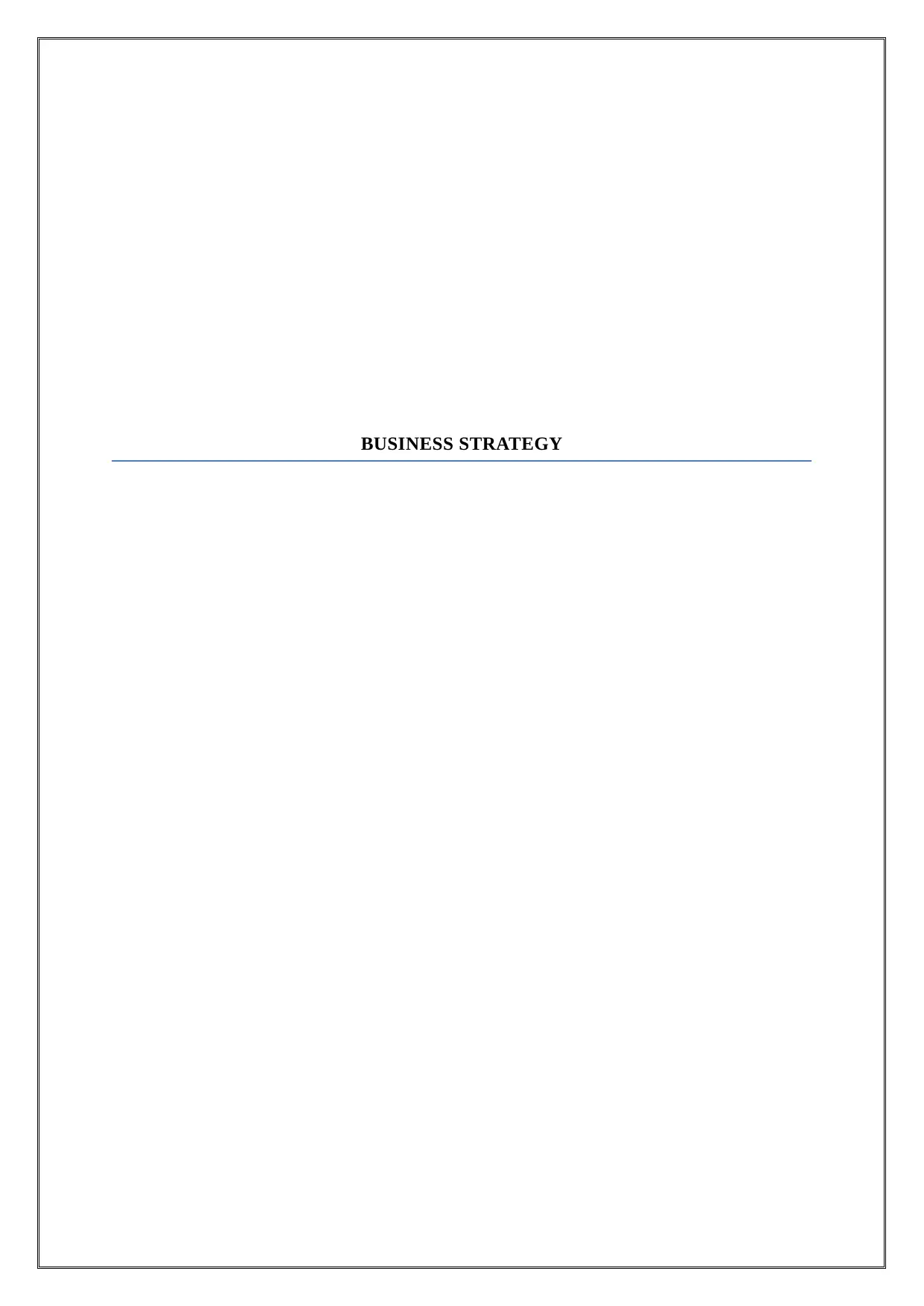
BUSINESS STRATEGY
Secure Best Marks with AI Grader
Need help grading? Try our AI Grader for instant feedback on your assignments.
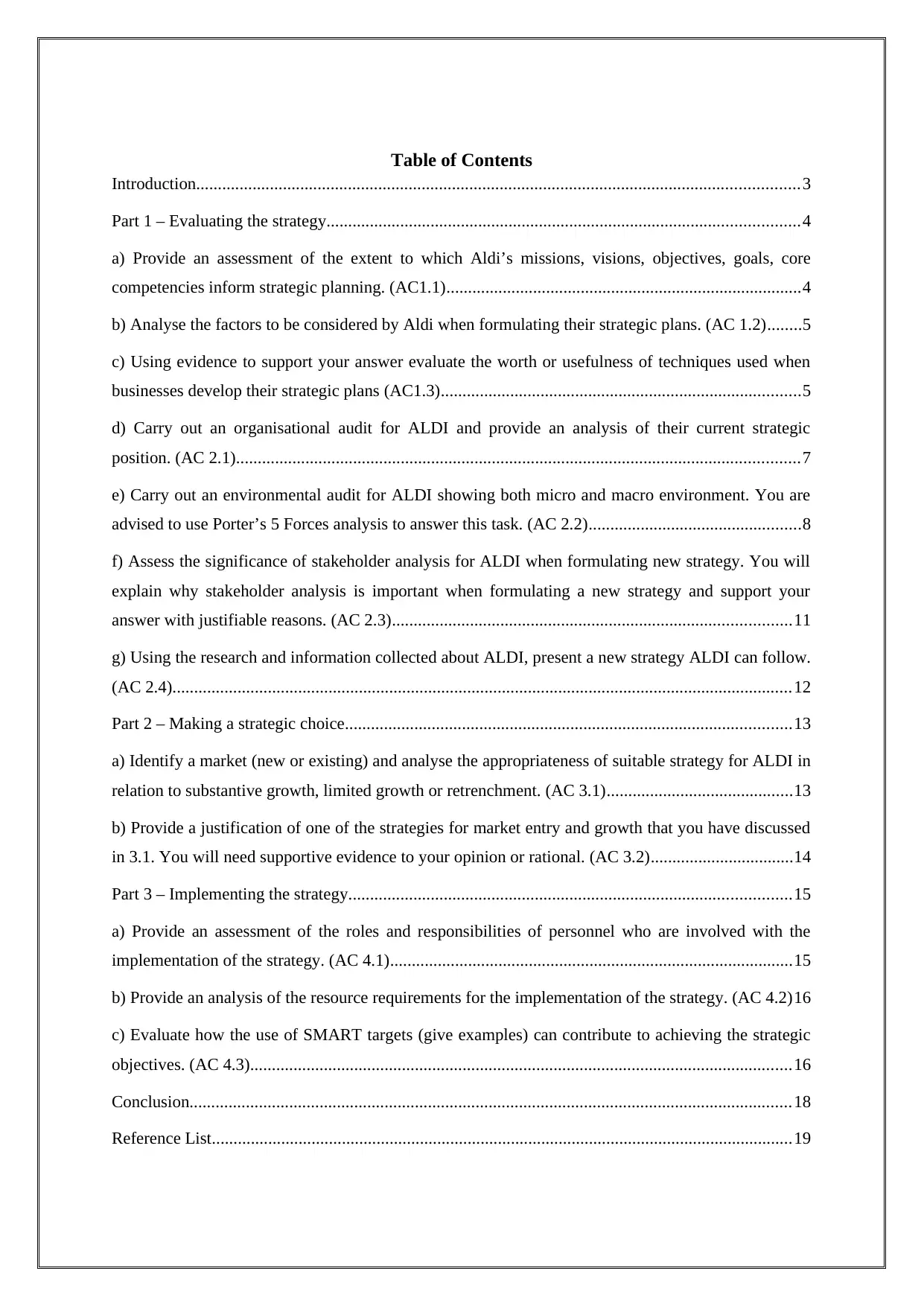
Table of Contents
Introduction...........................................................................................................................................3
Part 1 – Evaluating the strategy.............................................................................................................4
a) Provide an assessment of the extent to which Aldi’s missions, visions, objectives, goals, core
competencies inform strategic planning. (AC1.1)..................................................................................4
b) Analyse the factors to be considered by Aldi when formulating their strategic plans. (AC 1.2)........5
c) Using evidence to support your answer evaluate the worth or usefulness of techniques used when
businesses develop their strategic plans (AC1.3)...................................................................................5
d) Carry out an organisational audit for ALDI and provide an analysis of their current strategic
position. (AC 2.1)..................................................................................................................................7
e) Carry out an environmental audit for ALDI showing both micro and macro environment. You are
advised to use Porter’s 5 Forces analysis to answer this task. (AC 2.2).................................................8
f) Assess the significance of stakeholder analysis for ALDI when formulating new strategy. You will
explain why stakeholder analysis is important when formulating a new strategy and support your
answer with justifiable reasons. (AC 2.3)............................................................................................11
g) Using the research and information collected about ALDI, present a new strategy ALDI can follow.
(AC 2.4)...............................................................................................................................................12
Part 2 – Making a strategic choice.......................................................................................................13
a) Identify a market (new or existing) and analyse the appropriateness of suitable strategy for ALDI in
relation to substantive growth, limited growth or retrenchment. (AC 3.1)...........................................13
b) Provide a justification of one of the strategies for market entry and growth that you have discussed
in 3.1. You will need supportive evidence to your opinion or rational. (AC 3.2).................................14
Part 3 – Implementing the strategy......................................................................................................15
a) Provide an assessment of the roles and responsibilities of personnel who are involved with the
implementation of the strategy. (AC 4.1).............................................................................................15
b) Provide an analysis of the resource requirements for the implementation of the strategy. (AC 4.2)16
c) Evaluate how the use of SMART targets (give examples) can contribute to achieving the strategic
objectives. (AC 4.3).............................................................................................................................16
Conclusion...........................................................................................................................................18
Reference List......................................................................................................................................19
Introduction...........................................................................................................................................3
Part 1 – Evaluating the strategy.............................................................................................................4
a) Provide an assessment of the extent to which Aldi’s missions, visions, objectives, goals, core
competencies inform strategic planning. (AC1.1)..................................................................................4
b) Analyse the factors to be considered by Aldi when formulating their strategic plans. (AC 1.2)........5
c) Using evidence to support your answer evaluate the worth or usefulness of techniques used when
businesses develop their strategic plans (AC1.3)...................................................................................5
d) Carry out an organisational audit for ALDI and provide an analysis of their current strategic
position. (AC 2.1)..................................................................................................................................7
e) Carry out an environmental audit for ALDI showing both micro and macro environment. You are
advised to use Porter’s 5 Forces analysis to answer this task. (AC 2.2).................................................8
f) Assess the significance of stakeholder analysis for ALDI when formulating new strategy. You will
explain why stakeholder analysis is important when formulating a new strategy and support your
answer with justifiable reasons. (AC 2.3)............................................................................................11
g) Using the research and information collected about ALDI, present a new strategy ALDI can follow.
(AC 2.4)...............................................................................................................................................12
Part 2 – Making a strategic choice.......................................................................................................13
a) Identify a market (new or existing) and analyse the appropriateness of suitable strategy for ALDI in
relation to substantive growth, limited growth or retrenchment. (AC 3.1)...........................................13
b) Provide a justification of one of the strategies for market entry and growth that you have discussed
in 3.1. You will need supportive evidence to your opinion or rational. (AC 3.2).................................14
Part 3 – Implementing the strategy......................................................................................................15
a) Provide an assessment of the roles and responsibilities of personnel who are involved with the
implementation of the strategy. (AC 4.1).............................................................................................15
b) Provide an analysis of the resource requirements for the implementation of the strategy. (AC 4.2)16
c) Evaluate how the use of SMART targets (give examples) can contribute to achieving the strategic
objectives. (AC 4.3).............................................................................................................................16
Conclusion...........................................................................................................................................18
Reference List......................................................................................................................................19
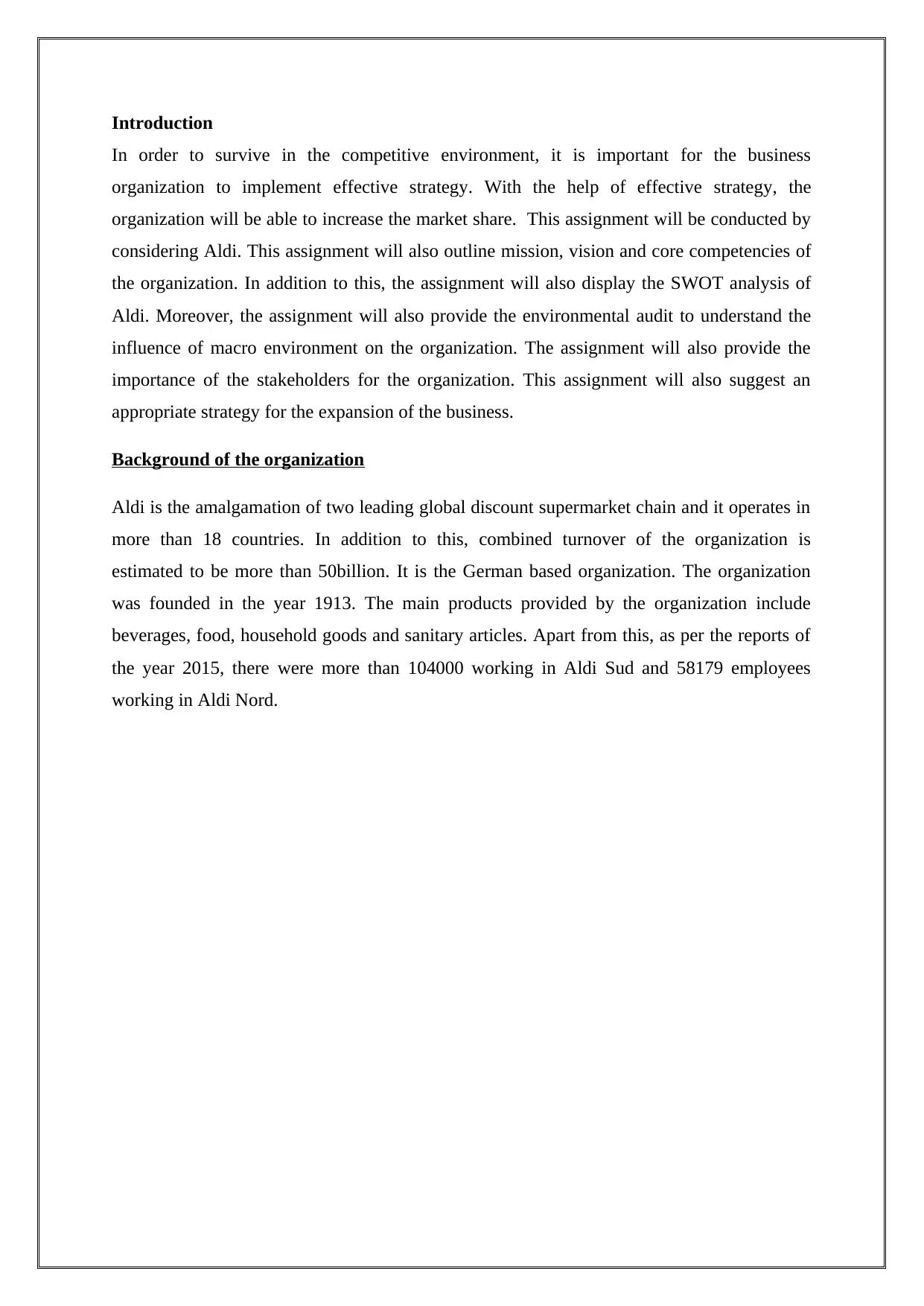
Introduction
In order to survive in the competitive environment, it is important for the business
organization to implement effective strategy. With the help of effective strategy, the
organization will be able to increase the market share. This assignment will be conducted by
considering Aldi. This assignment will also outline mission, vision and core competencies of
the organization. In addition to this, the assignment will also display the SWOT analysis of
Aldi. Moreover, the assignment will also provide the environmental audit to understand the
influence of macro environment on the organization. The assignment will also provide the
importance of the stakeholders for the organization. This assignment will also suggest an
appropriate strategy for the expansion of the business.
Background of the organization
Aldi is the amalgamation of two leading global discount supermarket chain and it operates in
more than 18 countries. In addition to this, combined turnover of the organization is
estimated to be more than 50billion. It is the German based organization. The organization
was founded in the year 1913. The main products provided by the organization include
beverages, food, household goods and sanitary articles. Apart from this, as per the reports of
the year 2015, there were more than 104000 working in Aldi Sud and 58179 employees
working in Aldi Nord.
In order to survive in the competitive environment, it is important for the business
organization to implement effective strategy. With the help of effective strategy, the
organization will be able to increase the market share. This assignment will be conducted by
considering Aldi. This assignment will also outline mission, vision and core competencies of
the organization. In addition to this, the assignment will also display the SWOT analysis of
Aldi. Moreover, the assignment will also provide the environmental audit to understand the
influence of macro environment on the organization. The assignment will also provide the
importance of the stakeholders for the organization. This assignment will also suggest an
appropriate strategy for the expansion of the business.
Background of the organization
Aldi is the amalgamation of two leading global discount supermarket chain and it operates in
more than 18 countries. In addition to this, combined turnover of the organization is
estimated to be more than 50billion. It is the German based organization. The organization
was founded in the year 1913. The main products provided by the organization include
beverages, food, household goods and sanitary articles. Apart from this, as per the reports of
the year 2015, there were more than 104000 working in Aldi Sud and 58179 employees
working in Aldi Nord.
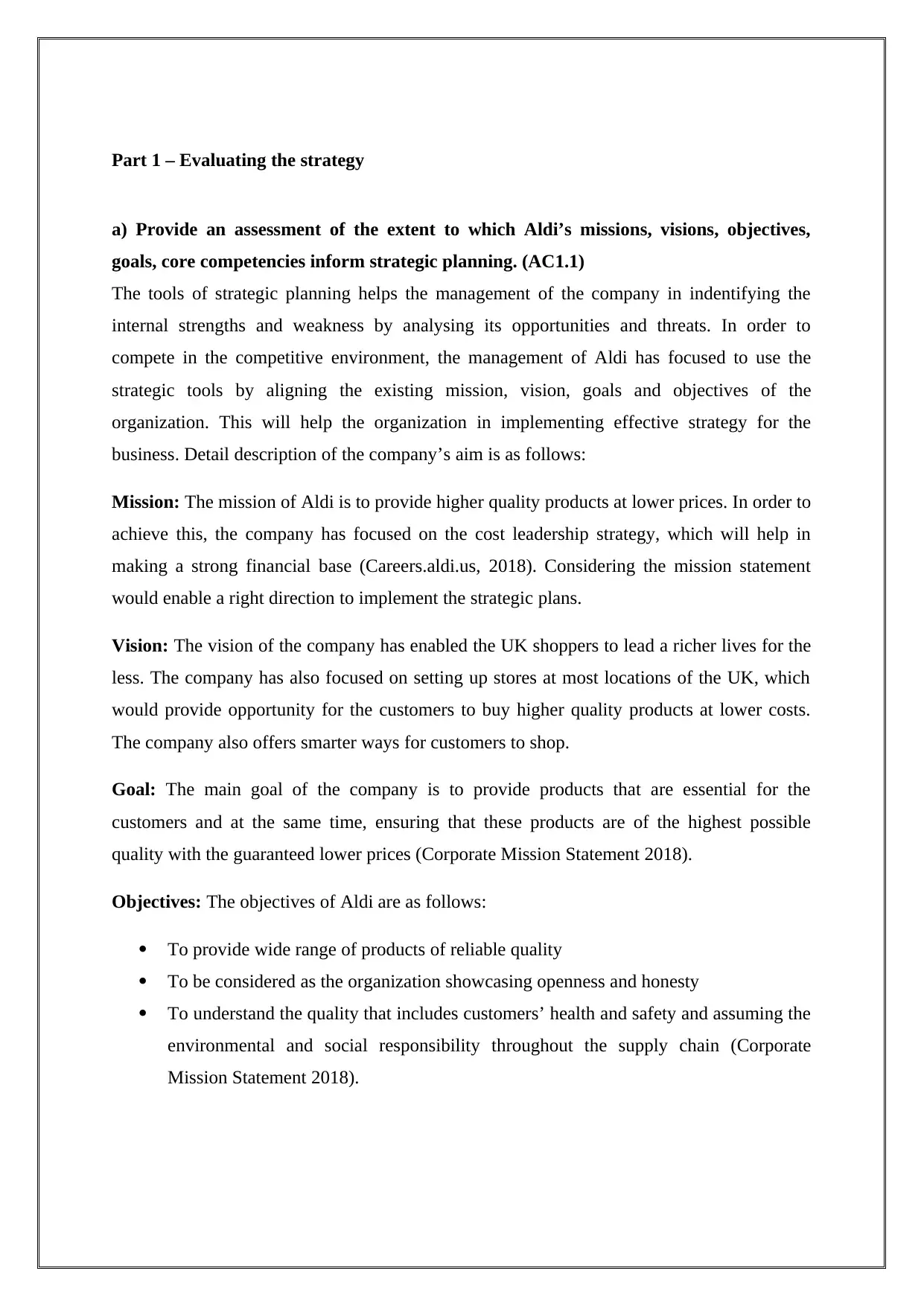
Part 1 – Evaluating the strategy
a) Provide an assessment of the extent to which Aldi’s missions, visions, objectives,
goals, core competencies inform strategic planning. (AC1.1)
The tools of strategic planning helps the management of the company in indentifying the
internal strengths and weakness by analysing its opportunities and threats. In order to
compete in the competitive environment, the management of Aldi has focused to use the
strategic tools by aligning the existing mission, vision, goals and objectives of the
organization. This will help the organization in implementing effective strategy for the
business. Detail description of the company’s aim is as follows:
Mission: The mission of Aldi is to provide higher quality products at lower prices. In order to
achieve this, the company has focused on the cost leadership strategy, which will help in
making a strong financial base (Careers.aldi.us, 2018). Considering the mission statement
would enable a right direction to implement the strategic plans.
Vision: The vision of the company has enabled the UK shoppers to lead a richer lives for the
less. The company has also focused on setting up stores at most locations of the UK, which
would provide opportunity for the customers to buy higher quality products at lower costs.
The company also offers smarter ways for customers to shop.
Goal: The main goal of the company is to provide products that are essential for the
customers and at the same time, ensuring that these products are of the highest possible
quality with the guaranteed lower prices (Corporate Mission Statement 2018).
Objectives: The objectives of Aldi are as follows:
To provide wide range of products of reliable quality
To be considered as the organization showcasing openness and honesty
To understand the quality that includes customers’ health and safety and assuming the
environmental and social responsibility throughout the supply chain (Corporate
Mission Statement 2018).
a) Provide an assessment of the extent to which Aldi’s missions, visions, objectives,
goals, core competencies inform strategic planning. (AC1.1)
The tools of strategic planning helps the management of the company in indentifying the
internal strengths and weakness by analysing its opportunities and threats. In order to
compete in the competitive environment, the management of Aldi has focused to use the
strategic tools by aligning the existing mission, vision, goals and objectives of the
organization. This will help the organization in implementing effective strategy for the
business. Detail description of the company’s aim is as follows:
Mission: The mission of Aldi is to provide higher quality products at lower prices. In order to
achieve this, the company has focused on the cost leadership strategy, which will help in
making a strong financial base (Careers.aldi.us, 2018). Considering the mission statement
would enable a right direction to implement the strategic plans.
Vision: The vision of the company has enabled the UK shoppers to lead a richer lives for the
less. The company has also focused on setting up stores at most locations of the UK, which
would provide opportunity for the customers to buy higher quality products at lower costs.
The company also offers smarter ways for customers to shop.
Goal: The main goal of the company is to provide products that are essential for the
customers and at the same time, ensuring that these products are of the highest possible
quality with the guaranteed lower prices (Corporate Mission Statement 2018).
Objectives: The objectives of Aldi are as follows:
To provide wide range of products of reliable quality
To be considered as the organization showcasing openness and honesty
To understand the quality that includes customers’ health and safety and assuming the
environmental and social responsibility throughout the supply chain (Corporate
Mission Statement 2018).
Secure Best Marks with AI Grader
Need help grading? Try our AI Grader for instant feedback on your assignments.
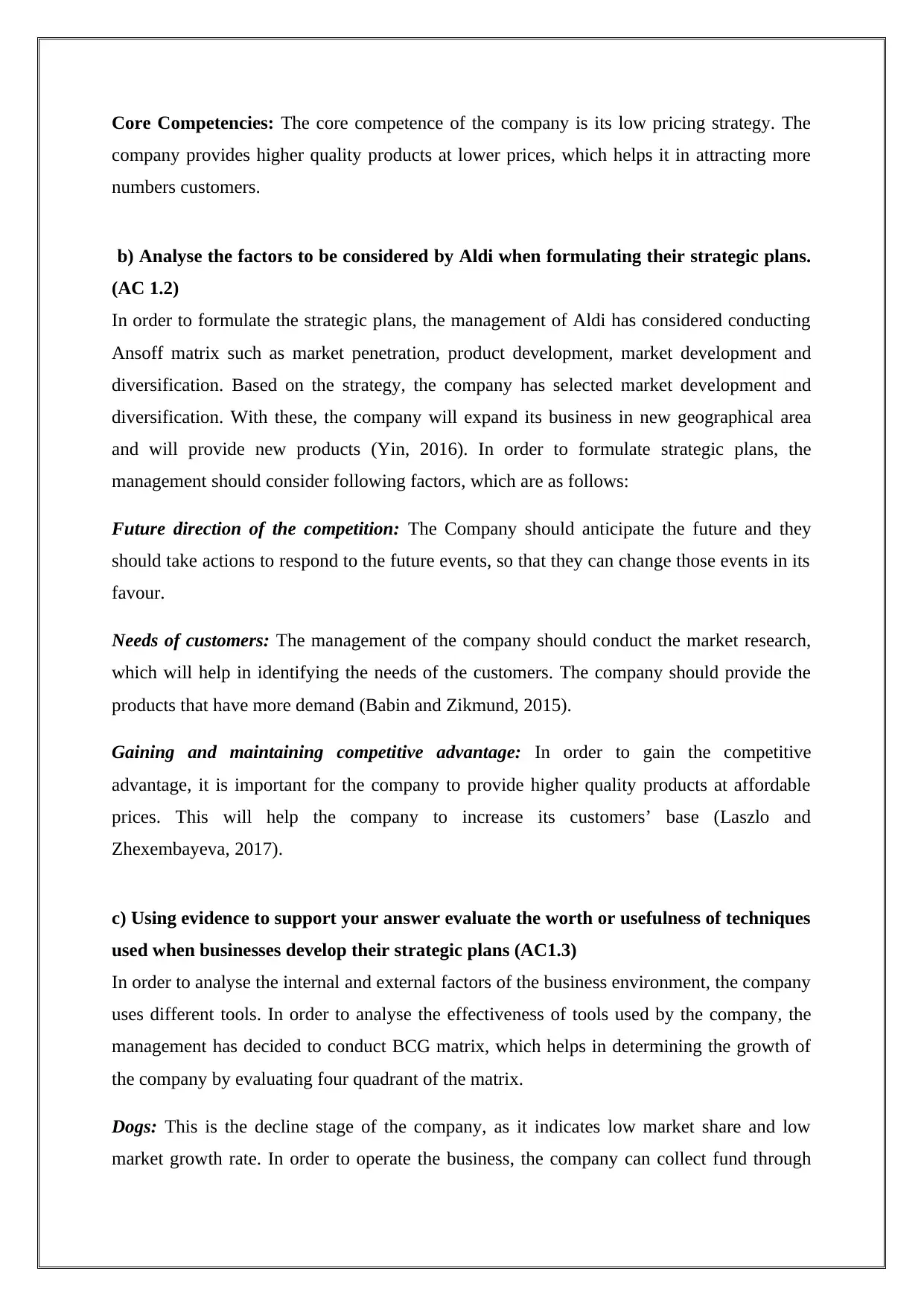
Core Competencies: The core competence of the company is its low pricing strategy. The
company provides higher quality products at lower prices, which helps it in attracting more
numbers customers.
b) Analyse the factors to be considered by Aldi when formulating their strategic plans.
(AC 1.2)
In order to formulate the strategic plans, the management of Aldi has considered conducting
Ansoff matrix such as market penetration, product development, market development and
diversification. Based on the strategy, the company has selected market development and
diversification. With these, the company will expand its business in new geographical area
and will provide new products (Yin, 2016). In order to formulate strategic plans, the
management should consider following factors, which are as follows:
Future direction of the competition: The Company should anticipate the future and they
should take actions to respond to the future events, so that they can change those events in its
favour.
Needs of customers: The management of the company should conduct the market research,
which will help in identifying the needs of the customers. The company should provide the
products that have more demand (Babin and Zikmund, 2015).
Gaining and maintaining competitive advantage: In order to gain the competitive
advantage, it is important for the company to provide higher quality products at affordable
prices. This will help the company to increase its customers’ base (Laszlo and
Zhexembayeva, 2017).
c) Using evidence to support your answer evaluate the worth or usefulness of techniques
used when businesses develop their strategic plans (AC1.3)
In order to analyse the internal and external factors of the business environment, the company
uses different tools. In order to analyse the effectiveness of tools used by the company, the
management has decided to conduct BCG matrix, which helps in determining the growth of
the company by evaluating four quadrant of the matrix.
Dogs: This is the decline stage of the company, as it indicates low market share and low
market growth rate. In order to operate the business, the company can collect fund through
company provides higher quality products at lower prices, which helps it in attracting more
numbers customers.
b) Analyse the factors to be considered by Aldi when formulating their strategic plans.
(AC 1.2)
In order to formulate the strategic plans, the management of Aldi has considered conducting
Ansoff matrix such as market penetration, product development, market development and
diversification. Based on the strategy, the company has selected market development and
diversification. With these, the company will expand its business in new geographical area
and will provide new products (Yin, 2016). In order to formulate strategic plans, the
management should consider following factors, which are as follows:
Future direction of the competition: The Company should anticipate the future and they
should take actions to respond to the future events, so that they can change those events in its
favour.
Needs of customers: The management of the company should conduct the market research,
which will help in identifying the needs of the customers. The company should provide the
products that have more demand (Babin and Zikmund, 2015).
Gaining and maintaining competitive advantage: In order to gain the competitive
advantage, it is important for the company to provide higher quality products at affordable
prices. This will help the company to increase its customers’ base (Laszlo and
Zhexembayeva, 2017).
c) Using evidence to support your answer evaluate the worth or usefulness of techniques
used when businesses develop their strategic plans (AC1.3)
In order to analyse the internal and external factors of the business environment, the company
uses different tools. In order to analyse the effectiveness of tools used by the company, the
management has decided to conduct BCG matrix, which helps in determining the growth of
the company by evaluating four quadrant of the matrix.
Dogs: This is the decline stage of the company, as it indicates low market share and low
market growth rate. In order to operate the business, the company can collect fund through
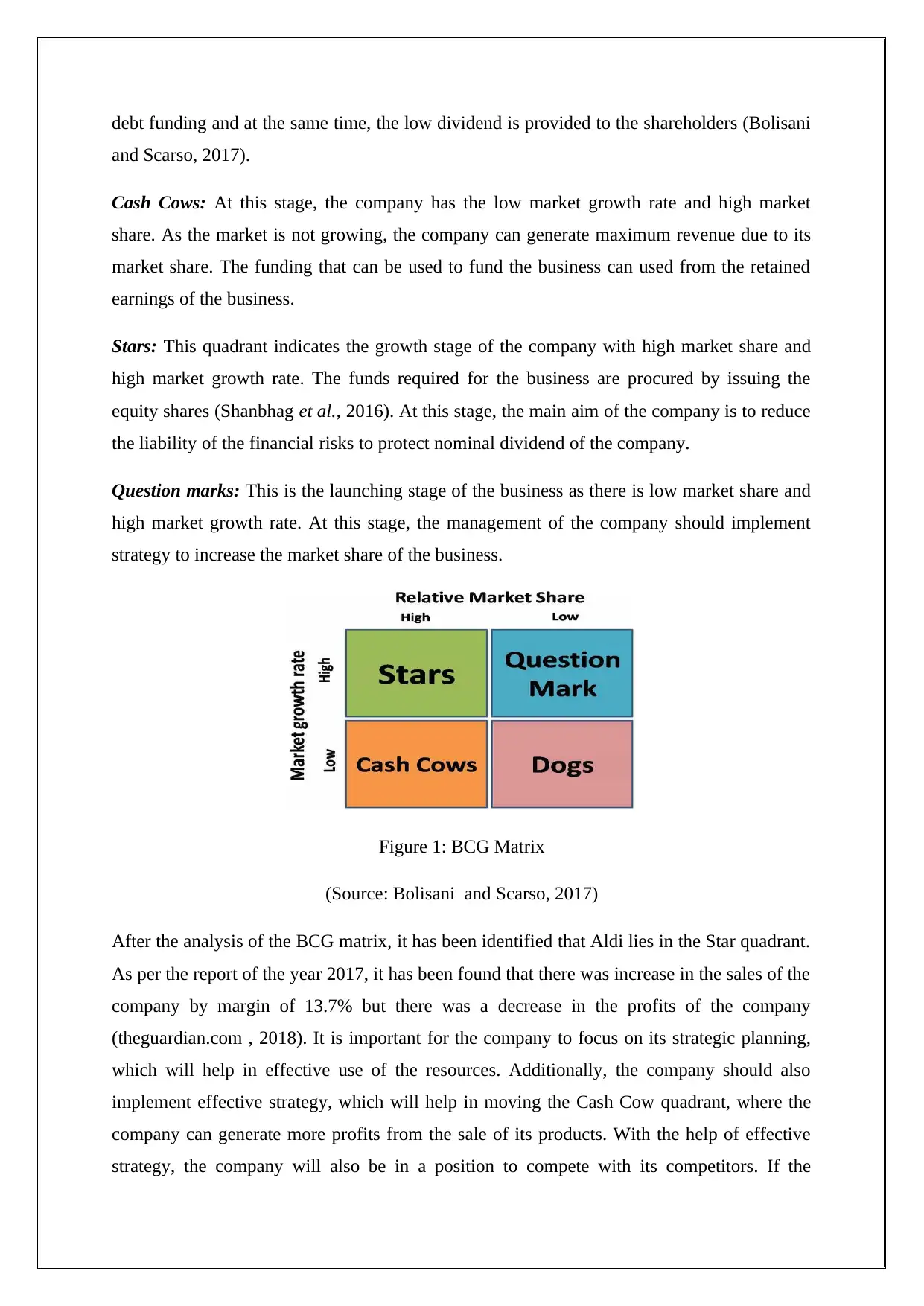
debt funding and at the same time, the low dividend is provided to the shareholders (Bolisani
and Scarso, 2017).
Cash Cows: At this stage, the company has the low market growth rate and high market
share. As the market is not growing, the company can generate maximum revenue due to its
market share. The funding that can be used to fund the business can used from the retained
earnings of the business.
Stars: This quadrant indicates the growth stage of the company with high market share and
high market growth rate. The funds required for the business are procured by issuing the
equity shares (Shanbhag et al., 2016). At this stage, the main aim of the company is to reduce
the liability of the financial risks to protect nominal dividend of the company.
Question marks: This is the launching stage of the business as there is low market share and
high market growth rate. At this stage, the management of the company should implement
strategy to increase the market share of the business.
Figure 1: BCG Matrix
(Source: Bolisani and Scarso, 2017)
After the analysis of the BCG matrix, it has been identified that Aldi lies in the Star quadrant.
As per the report of the year 2017, it has been found that there was increase in the sales of the
company by margin of 13.7% but there was a decrease in the profits of the company
(theguardian.com , 2018). It is important for the company to focus on its strategic planning,
which will help in effective use of the resources. Additionally, the company should also
implement effective strategy, which will help in moving the Cash Cow quadrant, where the
company can generate more profits from the sale of its products. With the help of effective
strategy, the company will also be in a position to compete with its competitors. If the
and Scarso, 2017).
Cash Cows: At this stage, the company has the low market growth rate and high market
share. As the market is not growing, the company can generate maximum revenue due to its
market share. The funding that can be used to fund the business can used from the retained
earnings of the business.
Stars: This quadrant indicates the growth stage of the company with high market share and
high market growth rate. The funds required for the business are procured by issuing the
equity shares (Shanbhag et al., 2016). At this stage, the main aim of the company is to reduce
the liability of the financial risks to protect nominal dividend of the company.
Question marks: This is the launching stage of the business as there is low market share and
high market growth rate. At this stage, the management of the company should implement
strategy to increase the market share of the business.
Figure 1: BCG Matrix
(Source: Bolisani and Scarso, 2017)
After the analysis of the BCG matrix, it has been identified that Aldi lies in the Star quadrant.
As per the report of the year 2017, it has been found that there was increase in the sales of the
company by margin of 13.7% but there was a decrease in the profits of the company
(theguardian.com , 2018). It is important for the company to focus on its strategic planning,
which will help in effective use of the resources. Additionally, the company should also
implement effective strategy, which will help in moving the Cash Cow quadrant, where the
company can generate more profits from the sale of its products. With the help of effective
strategy, the company will also be in a position to compete with its competitors. If the
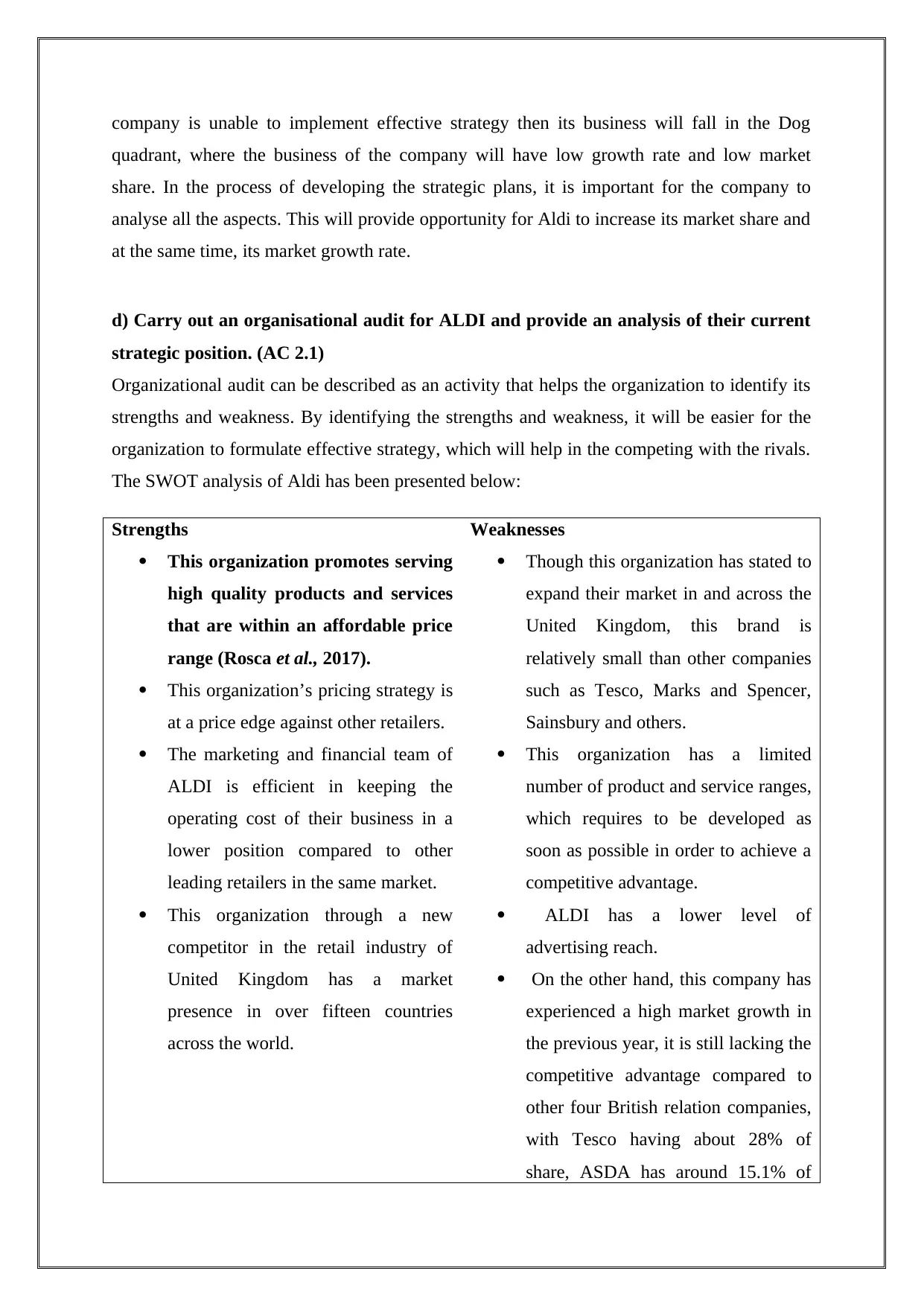
company is unable to implement effective strategy then its business will fall in the Dog
quadrant, where the business of the company will have low growth rate and low market
share. In the process of developing the strategic plans, it is important for the company to
analyse all the aspects. This will provide opportunity for Aldi to increase its market share and
at the same time, its market growth rate.
d) Carry out an organisational audit for ALDI and provide an analysis of their current
strategic position. (AC 2.1)
Organizational audit can be described as an activity that helps the organization to identify its
strengths and weakness. By identifying the strengths and weakness, it will be easier for the
organization to formulate effective strategy, which will help in the competing with the rivals.
The SWOT analysis of Aldi has been presented below:
Strengths
This organization promotes serving
high quality products and services
that are within an affordable price
range (Rosca et al., 2017).
This organization’s pricing strategy is
at a price edge against other retailers.
The marketing and financial team of
ALDI is efficient in keeping the
operating cost of their business in a
lower position compared to other
leading retailers in the same market.
This organization through a new
competitor in the retail industry of
United Kingdom has a market
presence in over fifteen countries
across the world.
Weaknesses
Though this organization has stated to
expand their market in and across the
United Kingdom, this brand is
relatively small than other companies
such as Tesco, Marks and Spencer,
Sainsbury and others.
This organization has a limited
number of product and service ranges,
which requires to be developed as
soon as possible in order to achieve a
competitive advantage.
ALDI has a lower level of
advertising reach.
On the other hand, this company has
experienced a high market growth in
the previous year, it is still lacking the
competitive advantage compared to
other four British relation companies,
with Tesco having about 28% of
share, ASDA has around 15.1% of
quadrant, where the business of the company will have low growth rate and low market
share. In the process of developing the strategic plans, it is important for the company to
analyse all the aspects. This will provide opportunity for Aldi to increase its market share and
at the same time, its market growth rate.
d) Carry out an organisational audit for ALDI and provide an analysis of their current
strategic position. (AC 2.1)
Organizational audit can be described as an activity that helps the organization to identify its
strengths and weakness. By identifying the strengths and weakness, it will be easier for the
organization to formulate effective strategy, which will help in the competing with the rivals.
The SWOT analysis of Aldi has been presented below:
Strengths
This organization promotes serving
high quality products and services
that are within an affordable price
range (Rosca et al., 2017).
This organization’s pricing strategy is
at a price edge against other retailers.
The marketing and financial team of
ALDI is efficient in keeping the
operating cost of their business in a
lower position compared to other
leading retailers in the same market.
This organization through a new
competitor in the retail industry of
United Kingdom has a market
presence in over fifteen countries
across the world.
Weaknesses
Though this organization has stated to
expand their market in and across the
United Kingdom, this brand is
relatively small than other companies
such as Tesco, Marks and Spencer,
Sainsbury and others.
This organization has a limited
number of product and service ranges,
which requires to be developed as
soon as possible in order to achieve a
competitive advantage.
ALDI has a lower level of
advertising reach.
On the other hand, this company has
experienced a high market growth in
the previous year, it is still lacking the
competitive advantage compared to
other four British relation companies,
with Tesco having about 28% of
share, ASDA has around 15.1% of
Paraphrase This Document
Need a fresh take? Get an instant paraphrase of this document with our AI Paraphraser
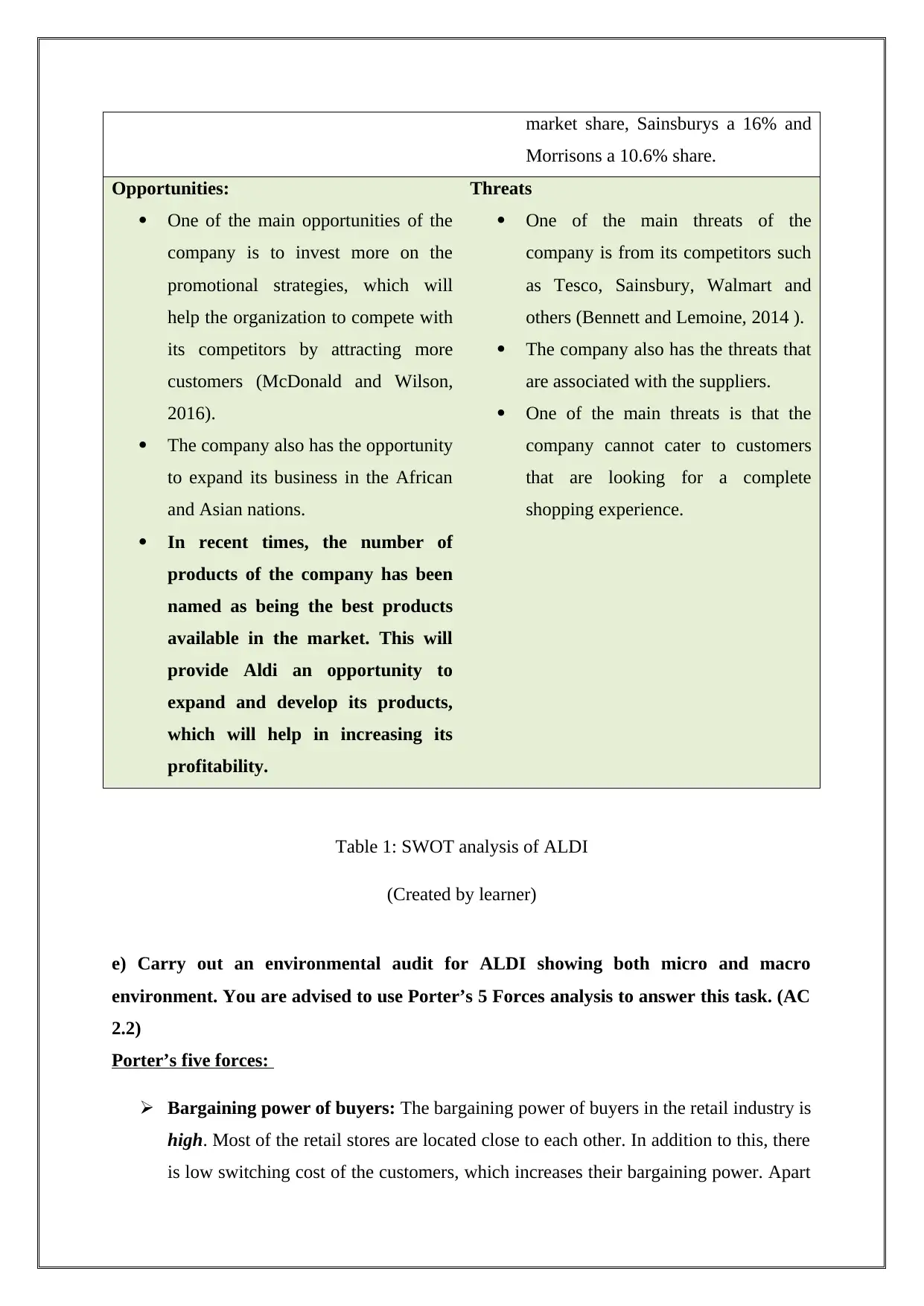
market share, Sainsburys a 16% and
Morrisons a 10.6% share.
Opportunities:
One of the main opportunities of the
company is to invest more on the
promotional strategies, which will
help the organization to compete with
its competitors by attracting more
customers (McDonald and Wilson,
2016).
The company also has the opportunity
to expand its business in the African
and Asian nations.
In recent times, the number of
products of the company has been
named as being the best products
available in the market. This will
provide Aldi an opportunity to
expand and develop its products,
which will help in increasing its
profitability.
Threats
One of the main threats of the
company is from its competitors such
as Tesco, Sainsbury, Walmart and
others (Bennett and Lemoine, 2014 ).
The company also has the threats that
are associated with the suppliers.
One of the main threats is that the
company cannot cater to customers
that are looking for a complete
shopping experience.
Table 1: SWOT analysis of ALDI
(Created by learner)
e) Carry out an environmental audit for ALDI showing both micro and macro
environment. You are advised to use Porter’s 5 Forces analysis to answer this task. (AC
2.2)
Porter’s five forces:
Bargaining power of buyers: The bargaining power of buyers in the retail industry is
high. Most of the retail stores are located close to each other. In addition to this, there
is low switching cost of the customers, which increases their bargaining power. Apart
Morrisons a 10.6% share.
Opportunities:
One of the main opportunities of the
company is to invest more on the
promotional strategies, which will
help the organization to compete with
its competitors by attracting more
customers (McDonald and Wilson,
2016).
The company also has the opportunity
to expand its business in the African
and Asian nations.
In recent times, the number of
products of the company has been
named as being the best products
available in the market. This will
provide Aldi an opportunity to
expand and develop its products,
which will help in increasing its
profitability.
Threats
One of the main threats of the
company is from its competitors such
as Tesco, Sainsbury, Walmart and
others (Bennett and Lemoine, 2014 ).
The company also has the threats that
are associated with the suppliers.
One of the main threats is that the
company cannot cater to customers
that are looking for a complete
shopping experience.
Table 1: SWOT analysis of ALDI
(Created by learner)
e) Carry out an environmental audit for ALDI showing both micro and macro
environment. You are advised to use Porter’s 5 Forces analysis to answer this task. (AC
2.2)
Porter’s five forces:
Bargaining power of buyers: The bargaining power of buyers in the retail industry is
high. Most of the retail stores are located close to each other. In addition to this, there
is low switching cost of the customers, which increases their bargaining power. Apart
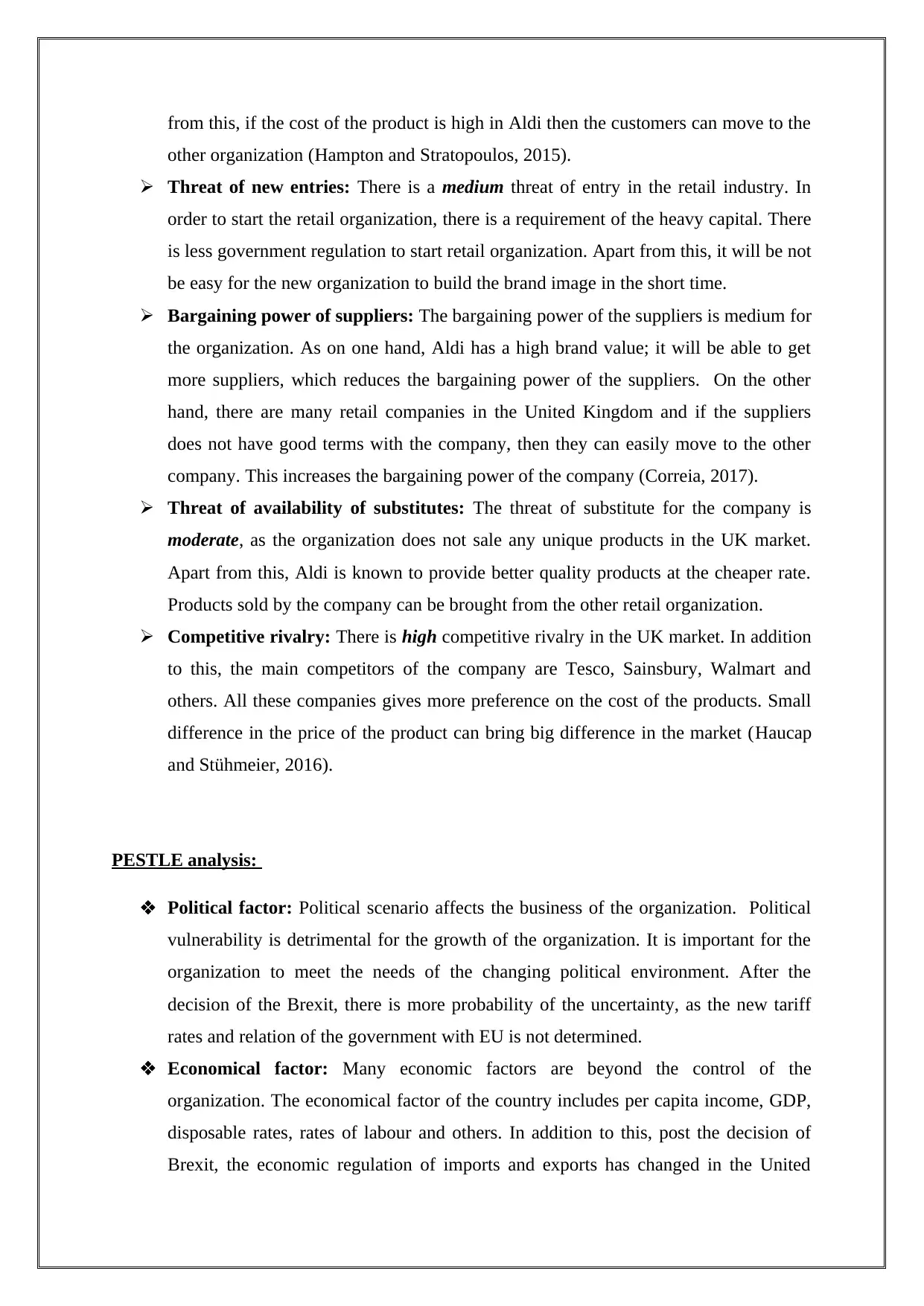
from this, if the cost of the product is high in Aldi then the customers can move to the
other organization (Hampton and Stratopoulos, 2015).
Threat of new entries: There is a medium threat of entry in the retail industry. In
order to start the retail organization, there is a requirement of the heavy capital. There
is less government regulation to start retail organization. Apart from this, it will be not
be easy for the new organization to build the brand image in the short time.
Bargaining power of suppliers: The bargaining power of the suppliers is medium for
the organization. As on one hand, Aldi has a high brand value; it will be able to get
more suppliers, which reduces the bargaining power of the suppliers. On the other
hand, there are many retail companies in the United Kingdom and if the suppliers
does not have good terms with the company, then they can easily move to the other
company. This increases the bargaining power of the company (Correia, 2017).
Threat of availability of substitutes: The threat of substitute for the company is
moderate, as the organization does not sale any unique products in the UK market.
Apart from this, Aldi is known to provide better quality products at the cheaper rate.
Products sold by the company can be brought from the other retail organization.
Competitive rivalry: There is high competitive rivalry in the UK market. In addition
to this, the main competitors of the company are Tesco, Sainsbury, Walmart and
others. All these companies gives more preference on the cost of the products. Small
difference in the price of the product can bring big difference in the market (Haucap
and Stühmeier, 2016).
PESTLE analysis:
Political factor: Political scenario affects the business of the organization. Political
vulnerability is detrimental for the growth of the organization. It is important for the
organization to meet the needs of the changing political environment. After the
decision of the Brexit, there is more probability of the uncertainty, as the new tariff
rates and relation of the government with EU is not determined.
Economical factor: Many economic factors are beyond the control of the
organization. The economical factor of the country includes per capita income, GDP,
disposable rates, rates of labour and others. In addition to this, post the decision of
Brexit, the economic regulation of imports and exports has changed in the United
other organization (Hampton and Stratopoulos, 2015).
Threat of new entries: There is a medium threat of entry in the retail industry. In
order to start the retail organization, there is a requirement of the heavy capital. There
is less government regulation to start retail organization. Apart from this, it will be not
be easy for the new organization to build the brand image in the short time.
Bargaining power of suppliers: The bargaining power of the suppliers is medium for
the organization. As on one hand, Aldi has a high brand value; it will be able to get
more suppliers, which reduces the bargaining power of the suppliers. On the other
hand, there are many retail companies in the United Kingdom and if the suppliers
does not have good terms with the company, then they can easily move to the other
company. This increases the bargaining power of the company (Correia, 2017).
Threat of availability of substitutes: The threat of substitute for the company is
moderate, as the organization does not sale any unique products in the UK market.
Apart from this, Aldi is known to provide better quality products at the cheaper rate.
Products sold by the company can be brought from the other retail organization.
Competitive rivalry: There is high competitive rivalry in the UK market. In addition
to this, the main competitors of the company are Tesco, Sainsbury, Walmart and
others. All these companies gives more preference on the cost of the products. Small
difference in the price of the product can bring big difference in the market (Haucap
and Stühmeier, 2016).
PESTLE analysis:
Political factor: Political scenario affects the business of the organization. Political
vulnerability is detrimental for the growth of the organization. It is important for the
organization to meet the needs of the changing political environment. After the
decision of the Brexit, there is more probability of the uncertainty, as the new tariff
rates and relation of the government with EU is not determined.
Economical factor: Many economic factors are beyond the control of the
organization. The economical factor of the country includes per capita income, GDP,
disposable rates, rates of labour and others. In addition to this, post the decision of
Brexit, the economic regulation of imports and exports has changed in the United
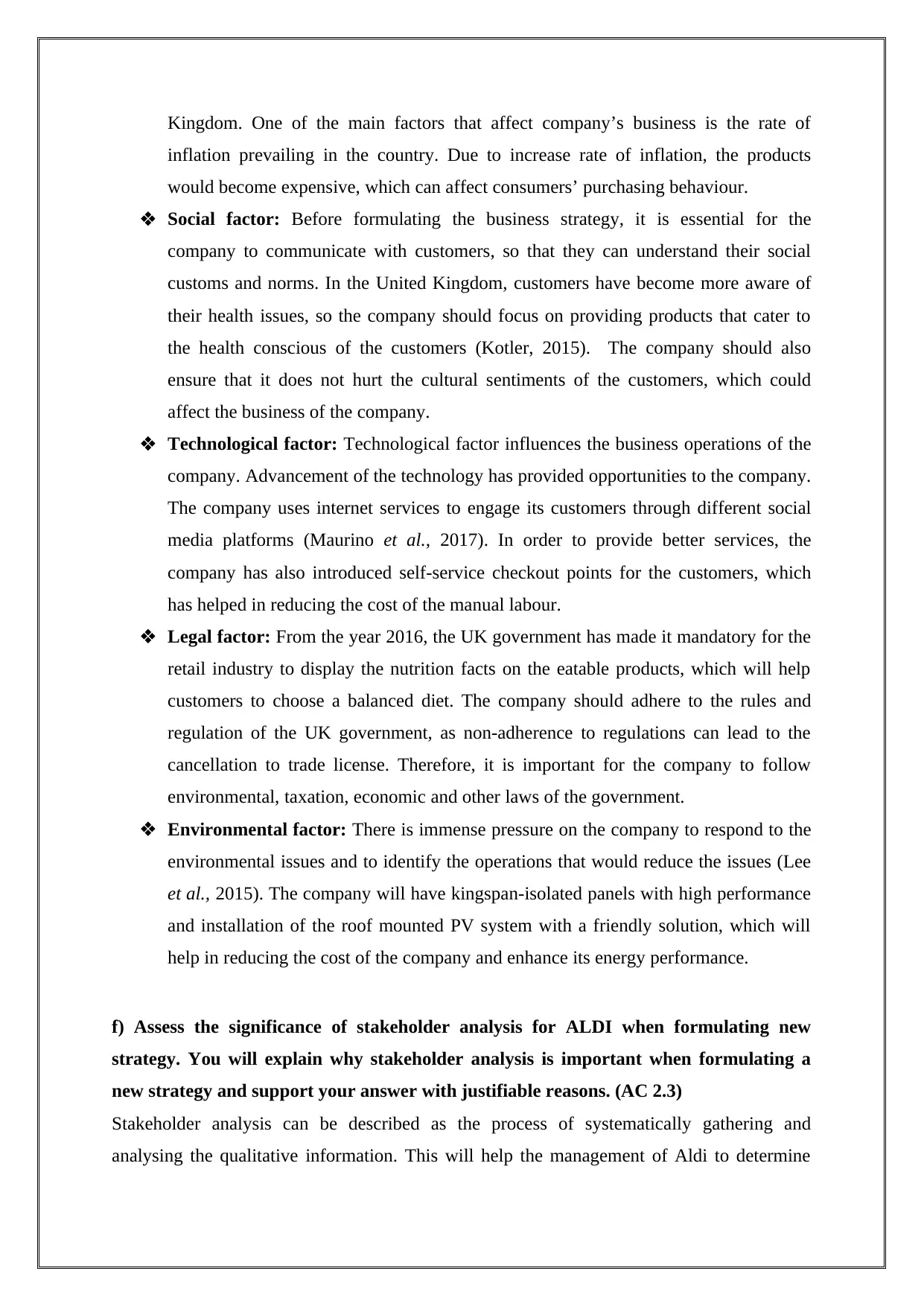
Kingdom. One of the main factors that affect company’s business is the rate of
inflation prevailing in the country. Due to increase rate of inflation, the products
would become expensive, which can affect consumers’ purchasing behaviour.
Social factor: Before formulating the business strategy, it is essential for the
company to communicate with customers, so that they can understand their social
customs and norms. In the United Kingdom, customers have become more aware of
their health issues, so the company should focus on providing products that cater to
the health conscious of the customers (Kotler, 2015). The company should also
ensure that it does not hurt the cultural sentiments of the customers, which could
affect the business of the company.
Technological factor: Technological factor influences the business operations of the
company. Advancement of the technology has provided opportunities to the company.
The company uses internet services to engage its customers through different social
media platforms (Maurino et al., 2017). In order to provide better services, the
company has also introduced self-service checkout points for the customers, which
has helped in reducing the cost of the manual labour.
Legal factor: From the year 2016, the UK government has made it mandatory for the
retail industry to display the nutrition facts on the eatable products, which will help
customers to choose a balanced diet. The company should adhere to the rules and
regulation of the UK government, as non-adherence to regulations can lead to the
cancellation to trade license. Therefore, it is important for the company to follow
environmental, taxation, economic and other laws of the government.
Environmental factor: There is immense pressure on the company to respond to the
environmental issues and to identify the operations that would reduce the issues (Lee
et al., 2015). The company will have kingspan-isolated panels with high performance
and installation of the roof mounted PV system with a friendly solution, which will
help in reducing the cost of the company and enhance its energy performance.
f) Assess the significance of stakeholder analysis for ALDI when formulating new
strategy. You will explain why stakeholder analysis is important when formulating a
new strategy and support your answer with justifiable reasons. (AC 2.3)
Stakeholder analysis can be described as the process of systematically gathering and
analysing the qualitative information. This will help the management of Aldi to determine
inflation prevailing in the country. Due to increase rate of inflation, the products
would become expensive, which can affect consumers’ purchasing behaviour.
Social factor: Before formulating the business strategy, it is essential for the
company to communicate with customers, so that they can understand their social
customs and norms. In the United Kingdom, customers have become more aware of
their health issues, so the company should focus on providing products that cater to
the health conscious of the customers (Kotler, 2015). The company should also
ensure that it does not hurt the cultural sentiments of the customers, which could
affect the business of the company.
Technological factor: Technological factor influences the business operations of the
company. Advancement of the technology has provided opportunities to the company.
The company uses internet services to engage its customers through different social
media platforms (Maurino et al., 2017). In order to provide better services, the
company has also introduced self-service checkout points for the customers, which
has helped in reducing the cost of the manual labour.
Legal factor: From the year 2016, the UK government has made it mandatory for the
retail industry to display the nutrition facts on the eatable products, which will help
customers to choose a balanced diet. The company should adhere to the rules and
regulation of the UK government, as non-adherence to regulations can lead to the
cancellation to trade license. Therefore, it is important for the company to follow
environmental, taxation, economic and other laws of the government.
Environmental factor: There is immense pressure on the company to respond to the
environmental issues and to identify the operations that would reduce the issues (Lee
et al., 2015). The company will have kingspan-isolated panels with high performance
and installation of the roof mounted PV system with a friendly solution, which will
help in reducing the cost of the company and enhance its energy performance.
f) Assess the significance of stakeholder analysis for ALDI when formulating new
strategy. You will explain why stakeholder analysis is important when formulating a
new strategy and support your answer with justifiable reasons. (AC 2.3)
Stakeholder analysis can be described as the process of systematically gathering and
analysing the qualitative information. This will help the management of Aldi to determine
Secure Best Marks with AI Grader
Need help grading? Try our AI Grader for instant feedback on your assignments.
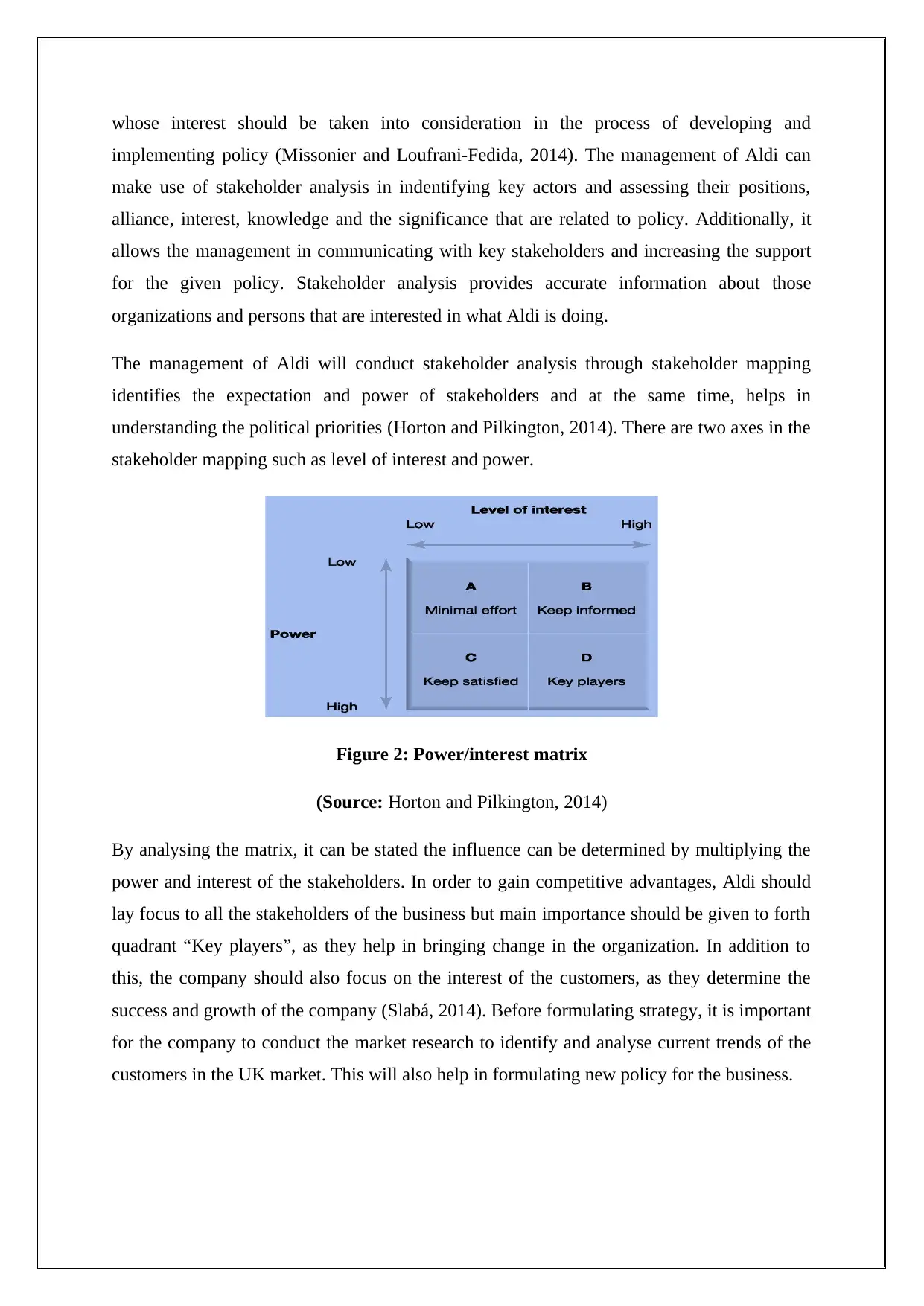
whose interest should be taken into consideration in the process of developing and
implementing policy (Missonier and Loufrani-Fedida, 2014). The management of Aldi can
make use of stakeholder analysis in indentifying key actors and assessing their positions,
alliance, interest, knowledge and the significance that are related to policy. Additionally, it
allows the management in communicating with key stakeholders and increasing the support
for the given policy. Stakeholder analysis provides accurate information about those
organizations and persons that are interested in what Aldi is doing.
The management of Aldi will conduct stakeholder analysis through stakeholder mapping
identifies the expectation and power of stakeholders and at the same time, helps in
understanding the political priorities (Horton and Pilkington, 2014). There are two axes in the
stakeholder mapping such as level of interest and power.
Figure 2: Power/interest matrix
(Source: Horton and Pilkington, 2014)
By analysing the matrix, it can be stated the influence can be determined by multiplying the
power and interest of the stakeholders. In order to gain competitive advantages, Aldi should
lay focus to all the stakeholders of the business but main importance should be given to forth
quadrant “Key players”, as they help in bringing change in the organization. In addition to
this, the company should also focus on the interest of the customers, as they determine the
success and growth of the company (Slabá, 2014). Before formulating strategy, it is important
for the company to conduct the market research to identify and analyse current trends of the
customers in the UK market. This will also help in formulating new policy for the business.
implementing policy (Missonier and Loufrani-Fedida, 2014). The management of Aldi can
make use of stakeholder analysis in indentifying key actors and assessing their positions,
alliance, interest, knowledge and the significance that are related to policy. Additionally, it
allows the management in communicating with key stakeholders and increasing the support
for the given policy. Stakeholder analysis provides accurate information about those
organizations and persons that are interested in what Aldi is doing.
The management of Aldi will conduct stakeholder analysis through stakeholder mapping
identifies the expectation and power of stakeholders and at the same time, helps in
understanding the political priorities (Horton and Pilkington, 2014). There are two axes in the
stakeholder mapping such as level of interest and power.
Figure 2: Power/interest matrix
(Source: Horton and Pilkington, 2014)
By analysing the matrix, it can be stated the influence can be determined by multiplying the
power and interest of the stakeholders. In order to gain competitive advantages, Aldi should
lay focus to all the stakeholders of the business but main importance should be given to forth
quadrant “Key players”, as they help in bringing change in the organization. In addition to
this, the company should also focus on the interest of the customers, as they determine the
success and growth of the company (Slabá, 2014). Before formulating strategy, it is important
for the company to conduct the market research to identify and analyse current trends of the
customers in the UK market. This will also help in formulating new policy for the business.
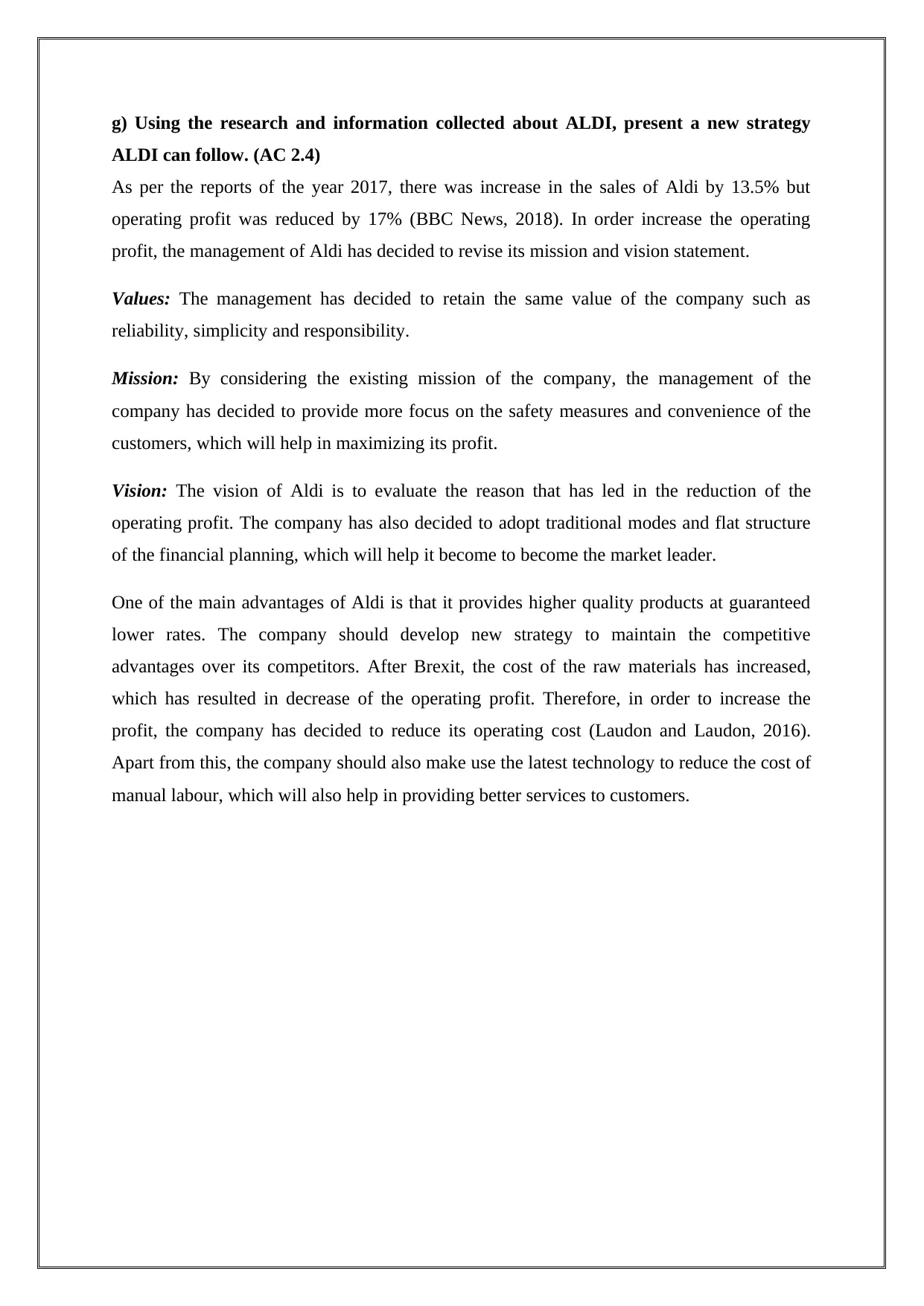
g) Using the research and information collected about ALDI, present a new strategy
ALDI can follow. (AC 2.4)
As per the reports of the year 2017, there was increase in the sales of Aldi by 13.5% but
operating profit was reduced by 17% (BBC News, 2018). In order increase the operating
profit, the management of Aldi has decided to revise its mission and vision statement.
Values: The management has decided to retain the same value of the company such as
reliability, simplicity and responsibility.
Mission: By considering the existing mission of the company, the management of the
company has decided to provide more focus on the safety measures and convenience of the
customers, which will help in maximizing its profit.
Vision: The vision of Aldi is to evaluate the reason that has led in the reduction of the
operating profit. The company has also decided to adopt traditional modes and flat structure
of the financial planning, which will help it become to become the market leader.
One of the main advantages of Aldi is that it provides higher quality products at guaranteed
lower rates. The company should develop new strategy to maintain the competitive
advantages over its competitors. After Brexit, the cost of the raw materials has increased,
which has resulted in decrease of the operating profit. Therefore, in order to increase the
profit, the company has decided to reduce its operating cost (Laudon and Laudon, 2016).
Apart from this, the company should also make use the latest technology to reduce the cost of
manual labour, which will also help in providing better services to customers.
ALDI can follow. (AC 2.4)
As per the reports of the year 2017, there was increase in the sales of Aldi by 13.5% but
operating profit was reduced by 17% (BBC News, 2018). In order increase the operating
profit, the management of Aldi has decided to revise its mission and vision statement.
Values: The management has decided to retain the same value of the company such as
reliability, simplicity and responsibility.
Mission: By considering the existing mission of the company, the management of the
company has decided to provide more focus on the safety measures and convenience of the
customers, which will help in maximizing its profit.
Vision: The vision of Aldi is to evaluate the reason that has led in the reduction of the
operating profit. The company has also decided to adopt traditional modes and flat structure
of the financial planning, which will help it become to become the market leader.
One of the main advantages of Aldi is that it provides higher quality products at guaranteed
lower rates. The company should develop new strategy to maintain the competitive
advantages over its competitors. After Brexit, the cost of the raw materials has increased,
which has resulted in decrease of the operating profit. Therefore, in order to increase the
profit, the company has decided to reduce its operating cost (Laudon and Laudon, 2016).
Apart from this, the company should also make use the latest technology to reduce the cost of
manual labour, which will also help in providing better services to customers.
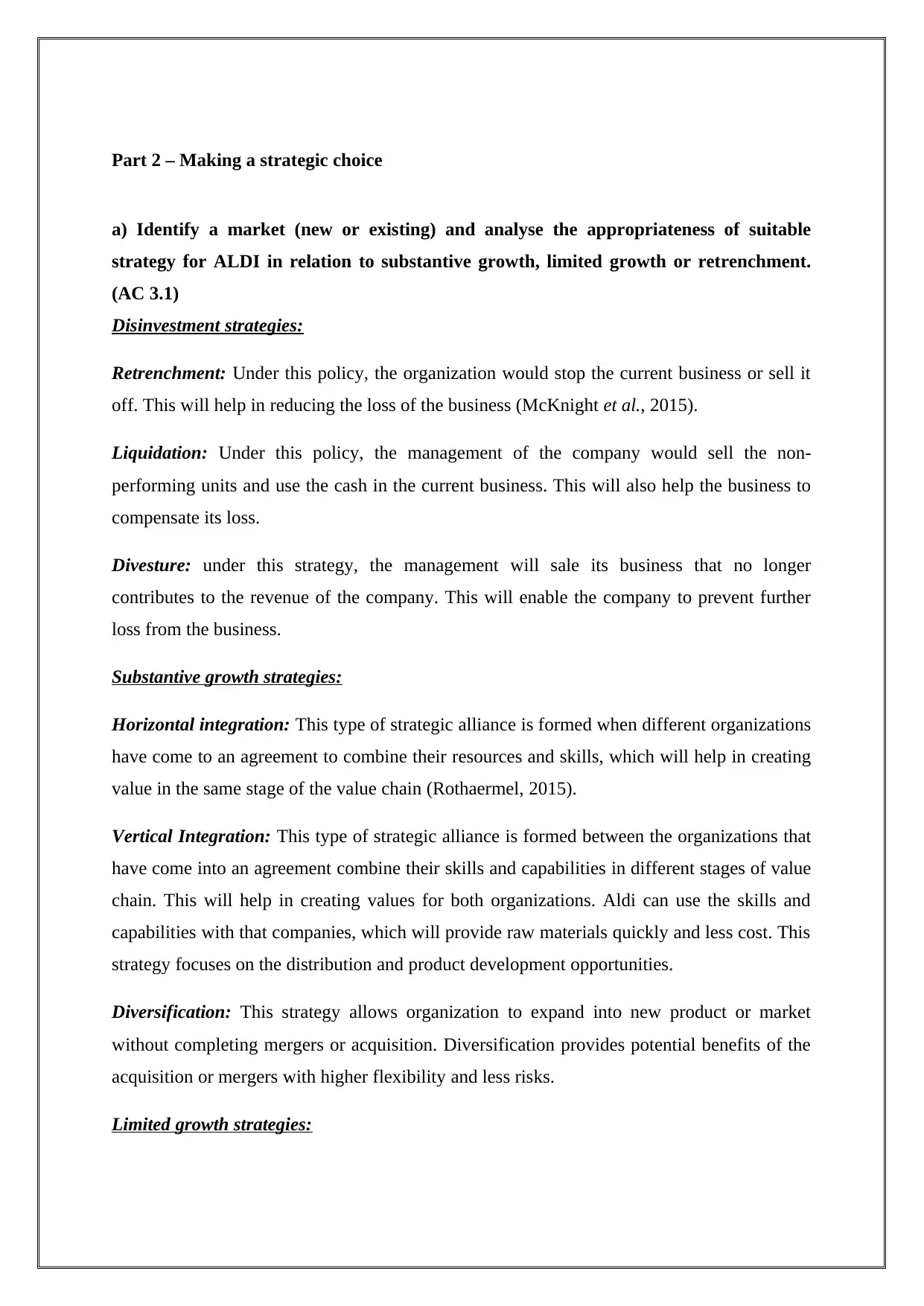
Part 2 – Making a strategic choice
a) Identify a market (new or existing) and analyse the appropriateness of suitable
strategy for ALDI in relation to substantive growth, limited growth or retrenchment.
(AC 3.1)
Disinvestment strategies:
Retrenchment: Under this policy, the organization would stop the current business or sell it
off. This will help in reducing the loss of the business (McKnight et al., 2015).
Liquidation: Under this policy, the management of the company would sell the non-
performing units and use the cash in the current business. This will also help the business to
compensate its loss.
Divesture: under this strategy, the management will sale its business that no longer
contributes to the revenue of the company. This will enable the company to prevent further
loss from the business.
Substantive growth strategies:
Horizontal integration: This type of strategic alliance is formed when different organizations
have come to an agreement to combine their resources and skills, which will help in creating
value in the same stage of the value chain (Rothaermel, 2015).
Vertical Integration: This type of strategic alliance is formed between the organizations that
have come into an agreement combine their skills and capabilities in different stages of value
chain. This will help in creating values for both organizations. Aldi can use the skills and
capabilities with that companies, which will provide raw materials quickly and less cost. This
strategy focuses on the distribution and product development opportunities.
Diversification: This strategy allows organization to expand into new product or market
without completing mergers or acquisition. Diversification provides potential benefits of the
acquisition or mergers with higher flexibility and less risks.
Limited growth strategies:
a) Identify a market (new or existing) and analyse the appropriateness of suitable
strategy for ALDI in relation to substantive growth, limited growth or retrenchment.
(AC 3.1)
Disinvestment strategies:
Retrenchment: Under this policy, the organization would stop the current business or sell it
off. This will help in reducing the loss of the business (McKnight et al., 2015).
Liquidation: Under this policy, the management of the company would sell the non-
performing units and use the cash in the current business. This will also help the business to
compensate its loss.
Divesture: under this strategy, the management will sale its business that no longer
contributes to the revenue of the company. This will enable the company to prevent further
loss from the business.
Substantive growth strategies:
Horizontal integration: This type of strategic alliance is formed when different organizations
have come to an agreement to combine their resources and skills, which will help in creating
value in the same stage of the value chain (Rothaermel, 2015).
Vertical Integration: This type of strategic alliance is formed between the organizations that
have come into an agreement combine their skills and capabilities in different stages of value
chain. This will help in creating values for both organizations. Aldi can use the skills and
capabilities with that companies, which will provide raw materials quickly and less cost. This
strategy focuses on the distribution and product development opportunities.
Diversification: This strategy allows organization to expand into new product or market
without completing mergers or acquisition. Diversification provides potential benefits of the
acquisition or mergers with higher flexibility and less risks.
Limited growth strategies:
Paraphrase This Document
Need a fresh take? Get an instant paraphrase of this document with our AI Paraphraser
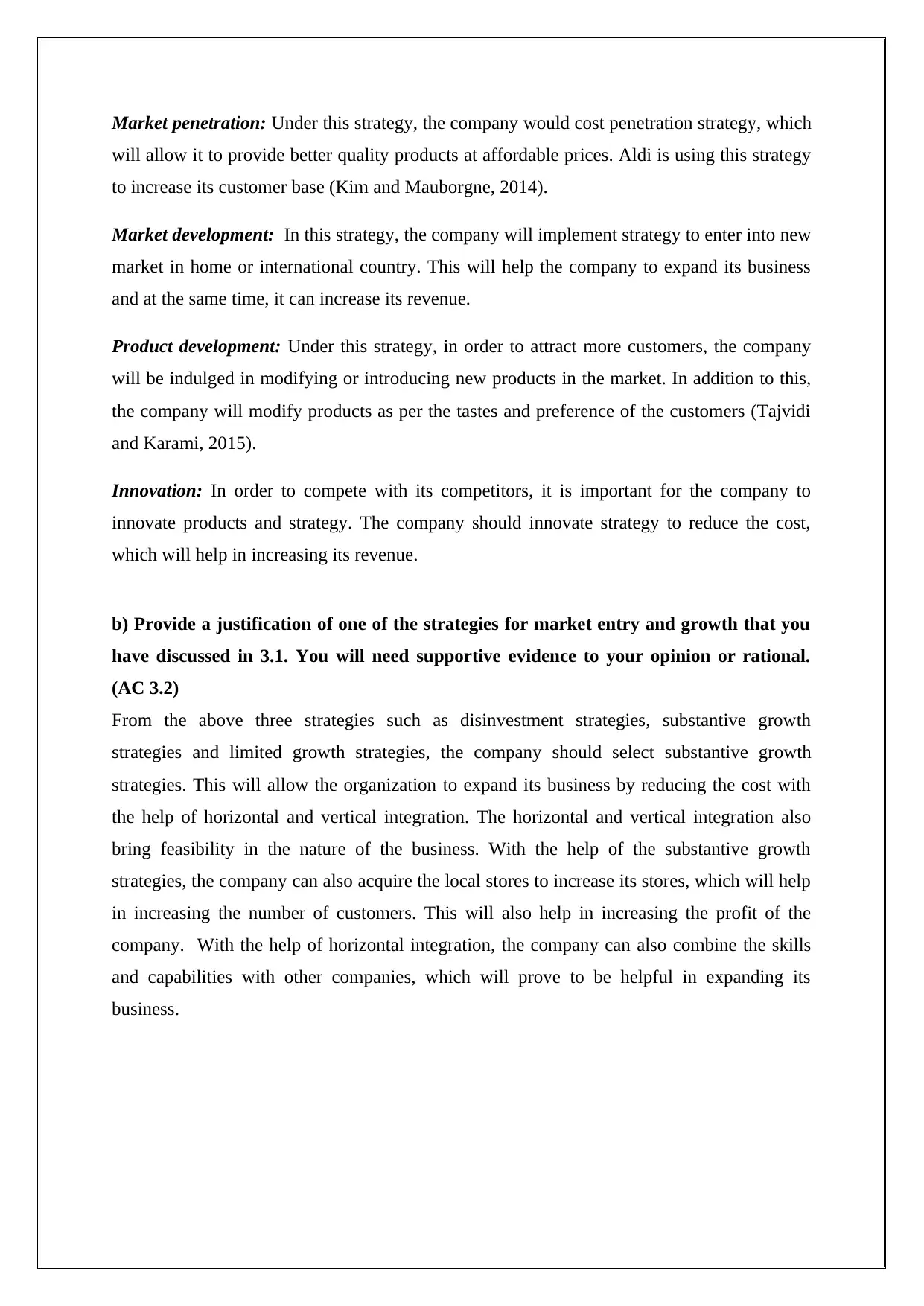
Market penetration: Under this strategy, the company would cost penetration strategy, which
will allow it to provide better quality products at affordable prices. Aldi is using this strategy
to increase its customer base (Kim and Mauborgne, 2014).
Market development: In this strategy, the company will implement strategy to enter into new
market in home or international country. This will help the company to expand its business
and at the same time, it can increase its revenue.
Product development: Under this strategy, in order to attract more customers, the company
will be indulged in modifying or introducing new products in the market. In addition to this,
the company will modify products as per the tastes and preference of the customers (Tajvidi
and Karami, 2015).
Innovation: In order to compete with its competitors, it is important for the company to
innovate products and strategy. The company should innovate strategy to reduce the cost,
which will help in increasing its revenue.
b) Provide a justification of one of the strategies for market entry and growth that you
have discussed in 3.1. You will need supportive evidence to your opinion or rational.
(AC 3.2)
From the above three strategies such as disinvestment strategies, substantive growth
strategies and limited growth strategies, the company should select substantive growth
strategies. This will allow the organization to expand its business by reducing the cost with
the help of horizontal and vertical integration. The horizontal and vertical integration also
bring feasibility in the nature of the business. With the help of the substantive growth
strategies, the company can also acquire the local stores to increase its stores, which will help
in increasing the number of customers. This will also help in increasing the profit of the
company. With the help of horizontal integration, the company can also combine the skills
and capabilities with other companies, which will prove to be helpful in expanding its
business.
will allow it to provide better quality products at affordable prices. Aldi is using this strategy
to increase its customer base (Kim and Mauborgne, 2014).
Market development: In this strategy, the company will implement strategy to enter into new
market in home or international country. This will help the company to expand its business
and at the same time, it can increase its revenue.
Product development: Under this strategy, in order to attract more customers, the company
will be indulged in modifying or introducing new products in the market. In addition to this,
the company will modify products as per the tastes and preference of the customers (Tajvidi
and Karami, 2015).
Innovation: In order to compete with its competitors, it is important for the company to
innovate products and strategy. The company should innovate strategy to reduce the cost,
which will help in increasing its revenue.
b) Provide a justification of one of the strategies for market entry and growth that you
have discussed in 3.1. You will need supportive evidence to your opinion or rational.
(AC 3.2)
From the above three strategies such as disinvestment strategies, substantive growth
strategies and limited growth strategies, the company should select substantive growth
strategies. This will allow the organization to expand its business by reducing the cost with
the help of horizontal and vertical integration. The horizontal and vertical integration also
bring feasibility in the nature of the business. With the help of the substantive growth
strategies, the company can also acquire the local stores to increase its stores, which will help
in increasing the number of customers. This will also help in increasing the profit of the
company. With the help of horizontal integration, the company can also combine the skills
and capabilities with other companies, which will prove to be helpful in expanding its
business.
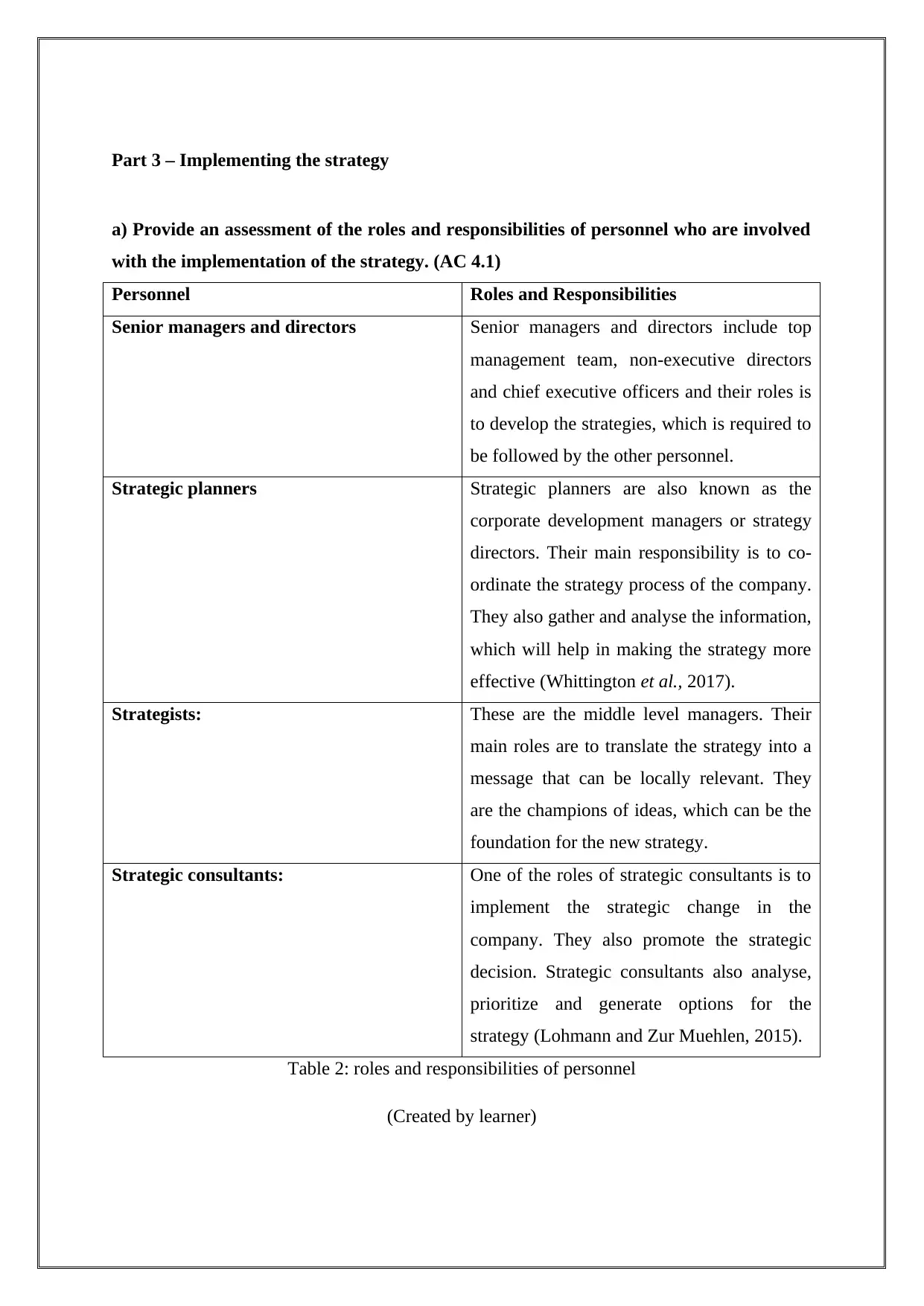
Part 3 – Implementing the strategy
a) Provide an assessment of the roles and responsibilities of personnel who are involved
with the implementation of the strategy. (AC 4.1)
Personnel Roles and Responsibilities
Senior managers and directors Senior managers and directors include top
management team, non-executive directors
and chief executive officers and their roles is
to develop the strategies, which is required to
be followed by the other personnel.
Strategic planners Strategic planners are also known as the
corporate development managers or strategy
directors. Their main responsibility is to co-
ordinate the strategy process of the company.
They also gather and analyse the information,
which will help in making the strategy more
effective (Whittington et al., 2017).
Strategists: These are the middle level managers. Their
main roles are to translate the strategy into a
message that can be locally relevant. They
are the champions of ideas, which can be the
foundation for the new strategy.
Strategic consultants: One of the roles of strategic consultants is to
implement the strategic change in the
company. They also promote the strategic
decision. Strategic consultants also analyse,
prioritize and generate options for the
strategy (Lohmann and Zur Muehlen, 2015).
Table 2: roles and responsibilities of personnel
(Created by learner)
a) Provide an assessment of the roles and responsibilities of personnel who are involved
with the implementation of the strategy. (AC 4.1)
Personnel Roles and Responsibilities
Senior managers and directors Senior managers and directors include top
management team, non-executive directors
and chief executive officers and their roles is
to develop the strategies, which is required to
be followed by the other personnel.
Strategic planners Strategic planners are also known as the
corporate development managers or strategy
directors. Their main responsibility is to co-
ordinate the strategy process of the company.
They also gather and analyse the information,
which will help in making the strategy more
effective (Whittington et al., 2017).
Strategists: These are the middle level managers. Their
main roles are to translate the strategy into a
message that can be locally relevant. They
are the champions of ideas, which can be the
foundation for the new strategy.
Strategic consultants: One of the roles of strategic consultants is to
implement the strategic change in the
company. They also promote the strategic
decision. Strategic consultants also analyse,
prioritize and generate options for the
strategy (Lohmann and Zur Muehlen, 2015).
Table 2: roles and responsibilities of personnel
(Created by learner)
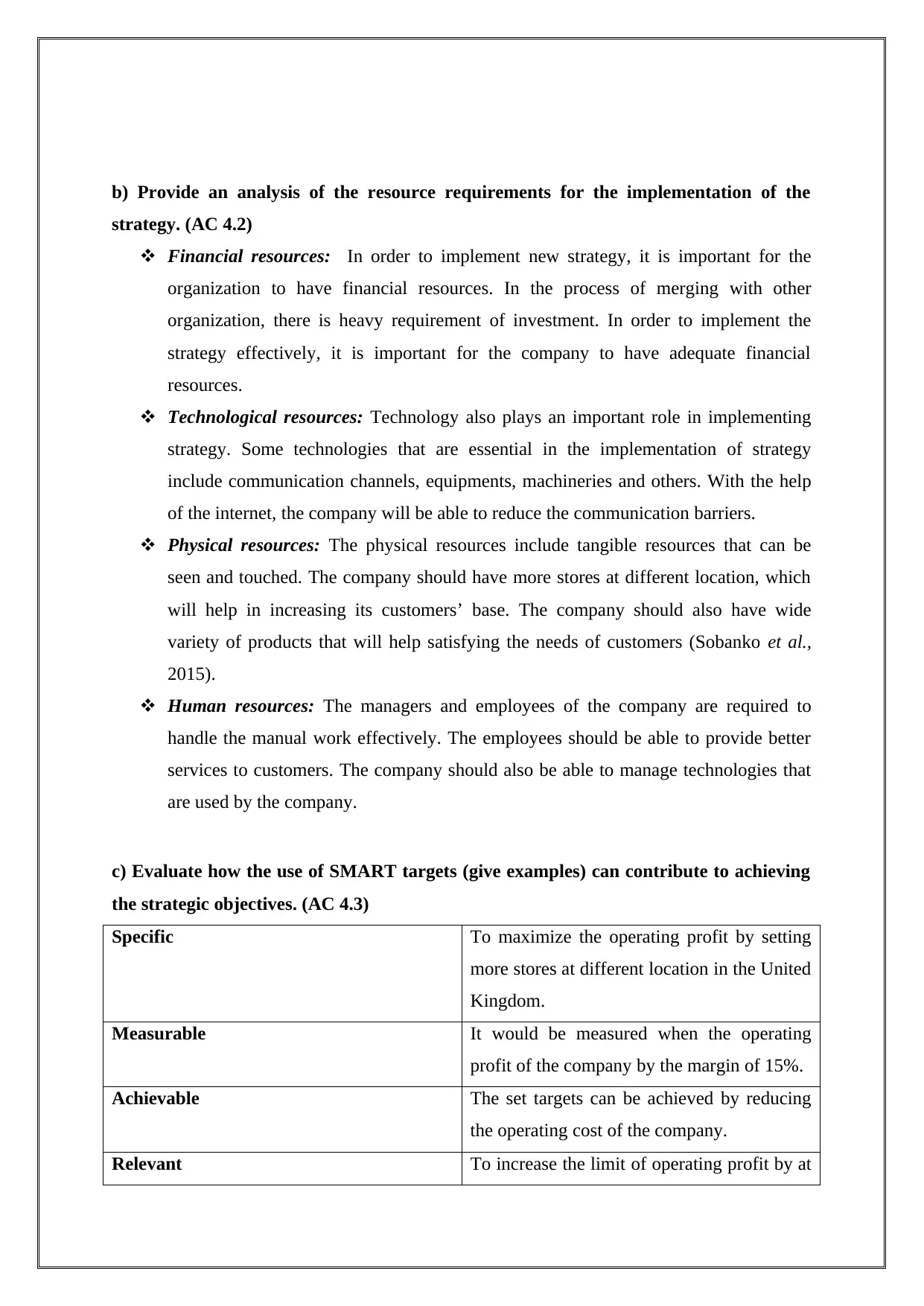
b) Provide an analysis of the resource requirements for the implementation of the
strategy. (AC 4.2)
Financial resources: In order to implement new strategy, it is important for the
organization to have financial resources. In the process of merging with other
organization, there is heavy requirement of investment. In order to implement the
strategy effectively, it is important for the company to have adequate financial
resources.
Technological resources: Technology also plays an important role in implementing
strategy. Some technologies that are essential in the implementation of strategy
include communication channels, equipments, machineries and others. With the help
of the internet, the company will be able to reduce the communication barriers.
Physical resources: The physical resources include tangible resources that can be
seen and touched. The company should have more stores at different location, which
will help in increasing its customers’ base. The company should also have wide
variety of products that will help satisfying the needs of customers (Sobanko et al.,
2015).
Human resources: The managers and employees of the company are required to
handle the manual work effectively. The employees should be able to provide better
services to customers. The company should also be able to manage technologies that
are used by the company.
c) Evaluate how the use of SMART targets (give examples) can contribute to achieving
the strategic objectives. (AC 4.3)
Specific To maximize the operating profit by setting
more stores at different location in the United
Kingdom.
Measurable It would be measured when the operating
profit of the company by the margin of 15%.
Achievable The set targets can be achieved by reducing
the operating cost of the company.
Relevant To increase the limit of operating profit by at
strategy. (AC 4.2)
Financial resources: In order to implement new strategy, it is important for the
organization to have financial resources. In the process of merging with other
organization, there is heavy requirement of investment. In order to implement the
strategy effectively, it is important for the company to have adequate financial
resources.
Technological resources: Technology also plays an important role in implementing
strategy. Some technologies that are essential in the implementation of strategy
include communication channels, equipments, machineries and others. With the help
of the internet, the company will be able to reduce the communication barriers.
Physical resources: The physical resources include tangible resources that can be
seen and touched. The company should have more stores at different location, which
will help in increasing its customers’ base. The company should also have wide
variety of products that will help satisfying the needs of customers (Sobanko et al.,
2015).
Human resources: The managers and employees of the company are required to
handle the manual work effectively. The employees should be able to provide better
services to customers. The company should also be able to manage technologies that
are used by the company.
c) Evaluate how the use of SMART targets (give examples) can contribute to achieving
the strategic objectives. (AC 4.3)
Specific To maximize the operating profit by setting
more stores at different location in the United
Kingdom.
Measurable It would be measured when the operating
profit of the company by the margin of 15%.
Achievable The set targets can be achieved by reducing
the operating cost of the company.
Relevant To increase the limit of operating profit by at
Secure Best Marks with AI Grader
Need help grading? Try our AI Grader for instant feedback on your assignments.
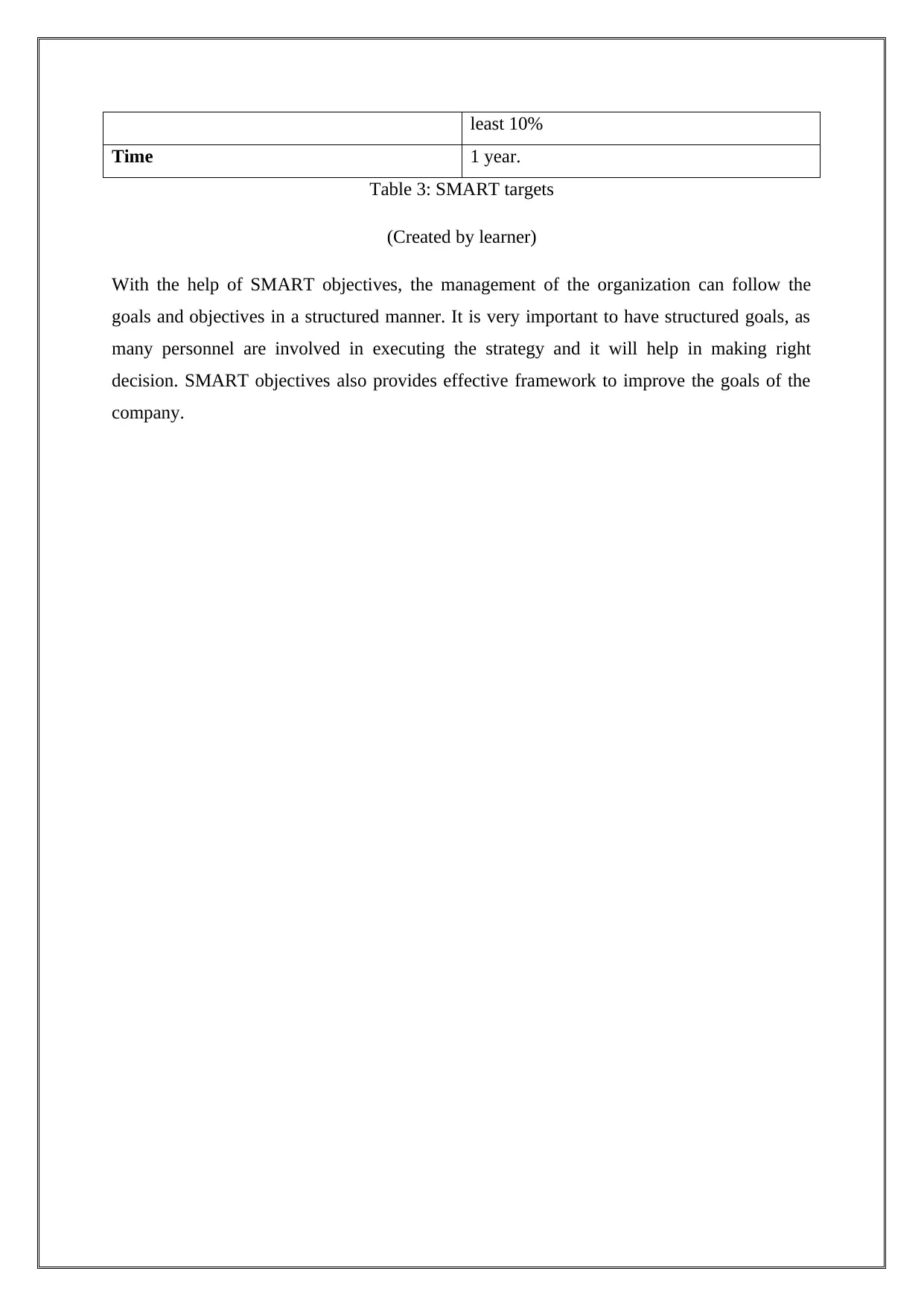
least 10%
Time 1 year.
Table 3: SMART targets
(Created by learner)
With the help of SMART objectives, the management of the organization can follow the
goals and objectives in a structured manner. It is very important to have structured goals, as
many personnel are involved in executing the strategy and it will help in making right
decision. SMART objectives also provides effective framework to improve the goals of the
company.
Time 1 year.
Table 3: SMART targets
(Created by learner)
With the help of SMART objectives, the management of the organization can follow the
goals and objectives in a structured manner. It is very important to have structured goals, as
many personnel are involved in executing the strategy and it will help in making right
decision. SMART objectives also provides effective framework to improve the goals of the
company.
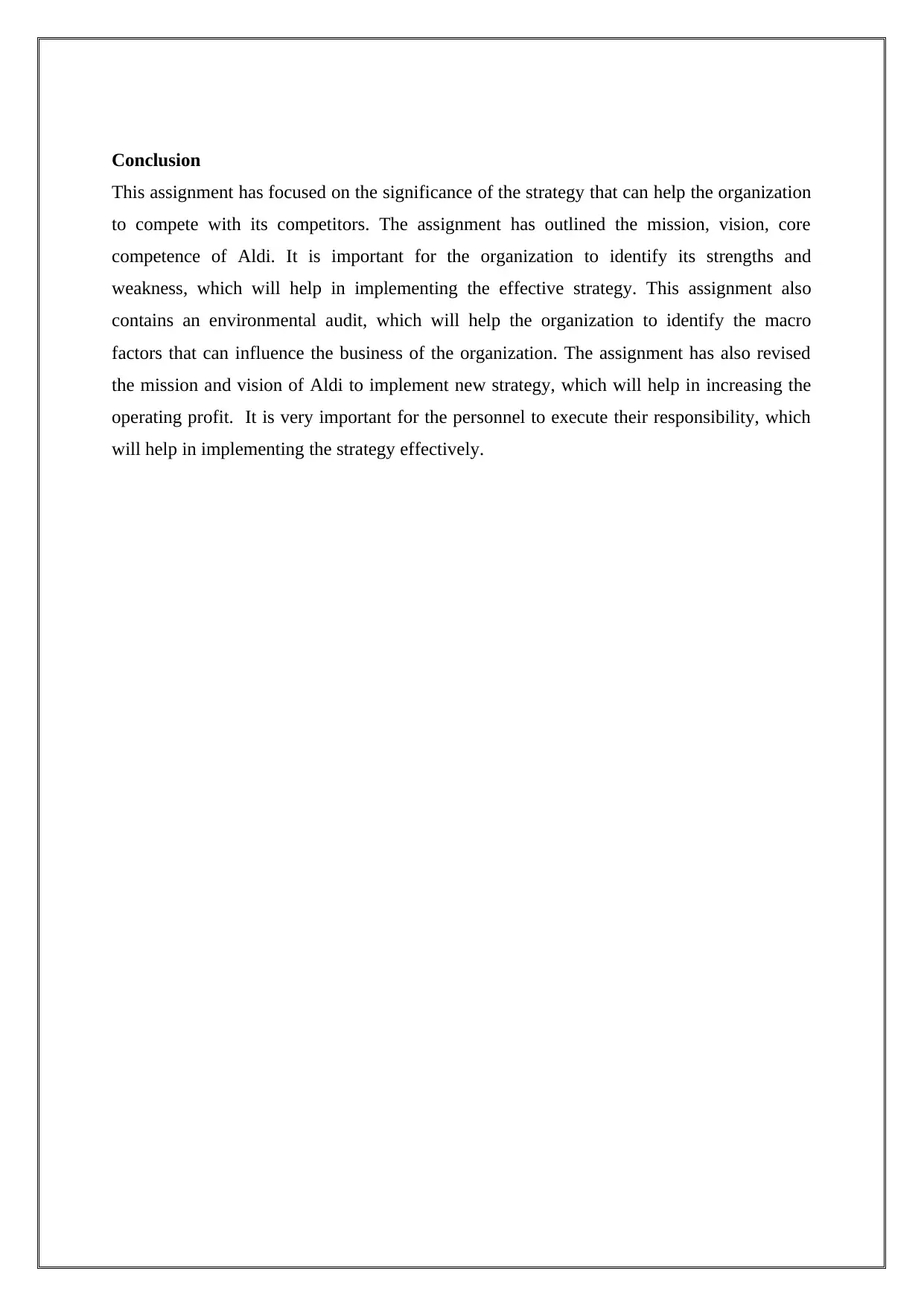
Conclusion
This assignment has focused on the significance of the strategy that can help the organization
to compete with its competitors. The assignment has outlined the mission, vision, core
competence of Aldi. It is important for the organization to identify its strengths and
weakness, which will help in implementing the effective strategy. This assignment also
contains an environmental audit, which will help the organization to identify the macro
factors that can influence the business of the organization. The assignment has also revised
the mission and vision of Aldi to implement new strategy, which will help in increasing the
operating profit. It is very important for the personnel to execute their responsibility, which
will help in implementing the strategy effectively.
This assignment has focused on the significance of the strategy that can help the organization
to compete with its competitors. The assignment has outlined the mission, vision, core
competence of Aldi. It is important for the organization to identify its strengths and
weakness, which will help in implementing the effective strategy. This assignment also
contains an environmental audit, which will help the organization to identify the macro
factors that can influence the business of the organization. The assignment has also revised
the mission and vision of Aldi to implement new strategy, which will help in increasing the
operating profit. It is very important for the personnel to execute their responsibility, which
will help in implementing the strategy effectively.
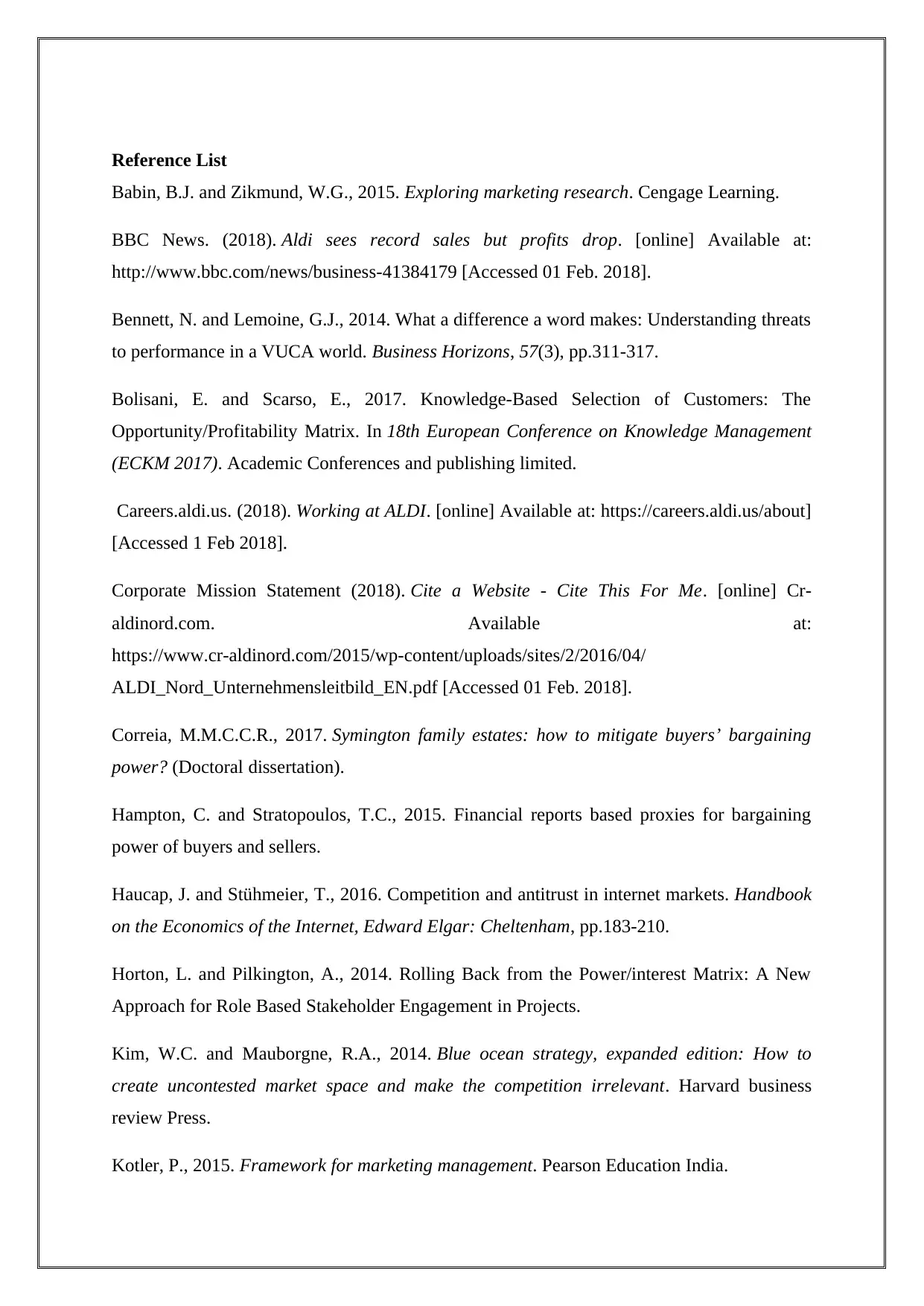
Reference List
Babin, B.J. and Zikmund, W.G., 2015. Exploring marketing research. Cengage Learning.
BBC News. (2018). Aldi sees record sales but profits drop. [online] Available at:
http://www.bbc.com/news/business-41384179 [Accessed 01 Feb. 2018].
Bennett, N. and Lemoine, G.J., 2014. What a difference a word makes: Understanding threats
to performance in a VUCA world. Business Horizons, 57(3), pp.311-317.
Bolisani, E. and Scarso, E., 2017. Knowledge-Based Selection of Customers: The
Opportunity/Profitability Matrix. In 18th European Conference on Knowledge Management
(ECKM 2017). Academic Conferences and publishing limited.
Careers.aldi.us. (2018). Working at ALDI. [online] Available at: https://careers.aldi.us/about]
[Accessed 1 Feb 2018].
Corporate Mission Statement (2018). Cite a Website - Cite This For Me. [online] Cr-
aldinord.com. Available at:
https://www.cr-aldinord.com/2015/wp-content/uploads/sites/2/2016/04/
ALDI_Nord_Unternehmensleitbild_EN.pdf [Accessed 01 Feb. 2018].
Correia, M.M.C.C.R., 2017. Symington family estates: how to mitigate buyers’ bargaining
power? (Doctoral dissertation).
Hampton, C. and Stratopoulos, T.C., 2015. Financial reports based proxies for bargaining
power of buyers and sellers.
Haucap, J. and Stühmeier, T., 2016. Competition and antitrust in internet markets. Handbook
on the Economics of the Internet, Edward Elgar: Cheltenham, pp.183-210.
Horton, L. and Pilkington, A., 2014. Rolling Back from the Power/interest Matrix: A New
Approach for Role Based Stakeholder Engagement in Projects.
Kim, W.C. and Mauborgne, R.A., 2014. Blue ocean strategy, expanded edition: How to
create uncontested market space and make the competition irrelevant. Harvard business
review Press.
Kotler, P., 2015. Framework for marketing management. Pearson Education India.
Babin, B.J. and Zikmund, W.G., 2015. Exploring marketing research. Cengage Learning.
BBC News. (2018). Aldi sees record sales but profits drop. [online] Available at:
http://www.bbc.com/news/business-41384179 [Accessed 01 Feb. 2018].
Bennett, N. and Lemoine, G.J., 2014. What a difference a word makes: Understanding threats
to performance in a VUCA world. Business Horizons, 57(3), pp.311-317.
Bolisani, E. and Scarso, E., 2017. Knowledge-Based Selection of Customers: The
Opportunity/Profitability Matrix. In 18th European Conference on Knowledge Management
(ECKM 2017). Academic Conferences and publishing limited.
Careers.aldi.us. (2018). Working at ALDI. [online] Available at: https://careers.aldi.us/about]
[Accessed 1 Feb 2018].
Corporate Mission Statement (2018). Cite a Website - Cite This For Me. [online] Cr-
aldinord.com. Available at:
https://www.cr-aldinord.com/2015/wp-content/uploads/sites/2/2016/04/
ALDI_Nord_Unternehmensleitbild_EN.pdf [Accessed 01 Feb. 2018].
Correia, M.M.C.C.R., 2017. Symington family estates: how to mitigate buyers’ bargaining
power? (Doctoral dissertation).
Hampton, C. and Stratopoulos, T.C., 2015. Financial reports based proxies for bargaining
power of buyers and sellers.
Haucap, J. and Stühmeier, T., 2016. Competition and antitrust in internet markets. Handbook
on the Economics of the Internet, Edward Elgar: Cheltenham, pp.183-210.
Horton, L. and Pilkington, A., 2014. Rolling Back from the Power/interest Matrix: A New
Approach for Role Based Stakeholder Engagement in Projects.
Kim, W.C. and Mauborgne, R.A., 2014. Blue ocean strategy, expanded edition: How to
create uncontested market space and make the competition irrelevant. Harvard business
review Press.
Kotler, P., 2015. Framework for marketing management. Pearson Education India.
Paraphrase This Document
Need a fresh take? Get an instant paraphrase of this document with our AI Paraphraser
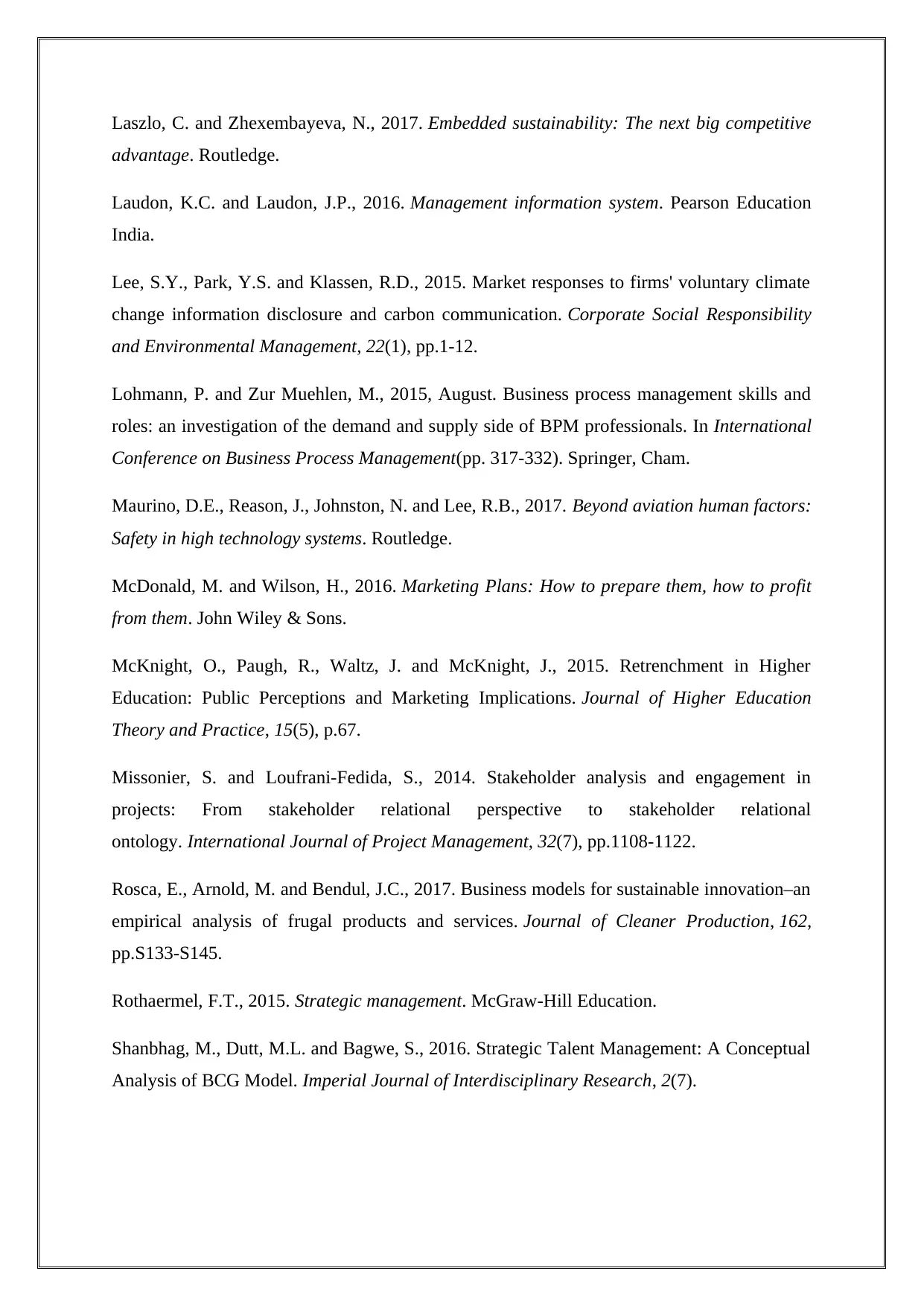
Laszlo, C. and Zhexembayeva, N., 2017. Embedded sustainability: The next big competitive
advantage. Routledge.
Laudon, K.C. and Laudon, J.P., 2016. Management information system. Pearson Education
India.
Lee, S.Y., Park, Y.S. and Klassen, R.D., 2015. Market responses to firms' voluntary climate
change information disclosure and carbon communication. Corporate Social Responsibility
and Environmental Management, 22(1), pp.1-12.
Lohmann, P. and Zur Muehlen, M., 2015, August. Business process management skills and
roles: an investigation of the demand and supply side of BPM professionals. In International
Conference on Business Process Management(pp. 317-332). Springer, Cham.
Maurino, D.E., Reason, J., Johnston, N. and Lee, R.B., 2017. Beyond aviation human factors:
Safety in high technology systems. Routledge.
McDonald, M. and Wilson, H., 2016. Marketing Plans: How to prepare them, how to profit
from them. John Wiley & Sons.
McKnight, O., Paugh, R., Waltz, J. and McKnight, J., 2015. Retrenchment in Higher
Education: Public Perceptions and Marketing Implications. Journal of Higher Education
Theory and Practice, 15(5), p.67.
Missonier, S. and Loufrani-Fedida, S., 2014. Stakeholder analysis and engagement in
projects: From stakeholder relational perspective to stakeholder relational
ontology. International Journal of Project Management, 32(7), pp.1108-1122.
Rosca, E., Arnold, M. and Bendul, J.C., 2017. Business models for sustainable innovation–an
empirical analysis of frugal products and services. Journal of Cleaner Production, 162,
pp.S133-S145.
Rothaermel, F.T., 2015. Strategic management. McGraw-Hill Education.
Shanbhag, M., Dutt, M.L. and Bagwe, S., 2016. Strategic Talent Management: A Conceptual
Analysis of BCG Model. Imperial Journal of Interdisciplinary Research, 2(7).
advantage. Routledge.
Laudon, K.C. and Laudon, J.P., 2016. Management information system. Pearson Education
India.
Lee, S.Y., Park, Y.S. and Klassen, R.D., 2015. Market responses to firms' voluntary climate
change information disclosure and carbon communication. Corporate Social Responsibility
and Environmental Management, 22(1), pp.1-12.
Lohmann, P. and Zur Muehlen, M., 2015, August. Business process management skills and
roles: an investigation of the demand and supply side of BPM professionals. In International
Conference on Business Process Management(pp. 317-332). Springer, Cham.
Maurino, D.E., Reason, J., Johnston, N. and Lee, R.B., 2017. Beyond aviation human factors:
Safety in high technology systems. Routledge.
McDonald, M. and Wilson, H., 2016. Marketing Plans: How to prepare them, how to profit
from them. John Wiley & Sons.
McKnight, O., Paugh, R., Waltz, J. and McKnight, J., 2015. Retrenchment in Higher
Education: Public Perceptions and Marketing Implications. Journal of Higher Education
Theory and Practice, 15(5), p.67.
Missonier, S. and Loufrani-Fedida, S., 2014. Stakeholder analysis and engagement in
projects: From stakeholder relational perspective to stakeholder relational
ontology. International Journal of Project Management, 32(7), pp.1108-1122.
Rosca, E., Arnold, M. and Bendul, J.C., 2017. Business models for sustainable innovation–an
empirical analysis of frugal products and services. Journal of Cleaner Production, 162,
pp.S133-S145.
Rothaermel, F.T., 2015. Strategic management. McGraw-Hill Education.
Shanbhag, M., Dutt, M.L. and Bagwe, S., 2016. Strategic Talent Management: A Conceptual
Analysis of BCG Model. Imperial Journal of Interdisciplinary Research, 2(7).
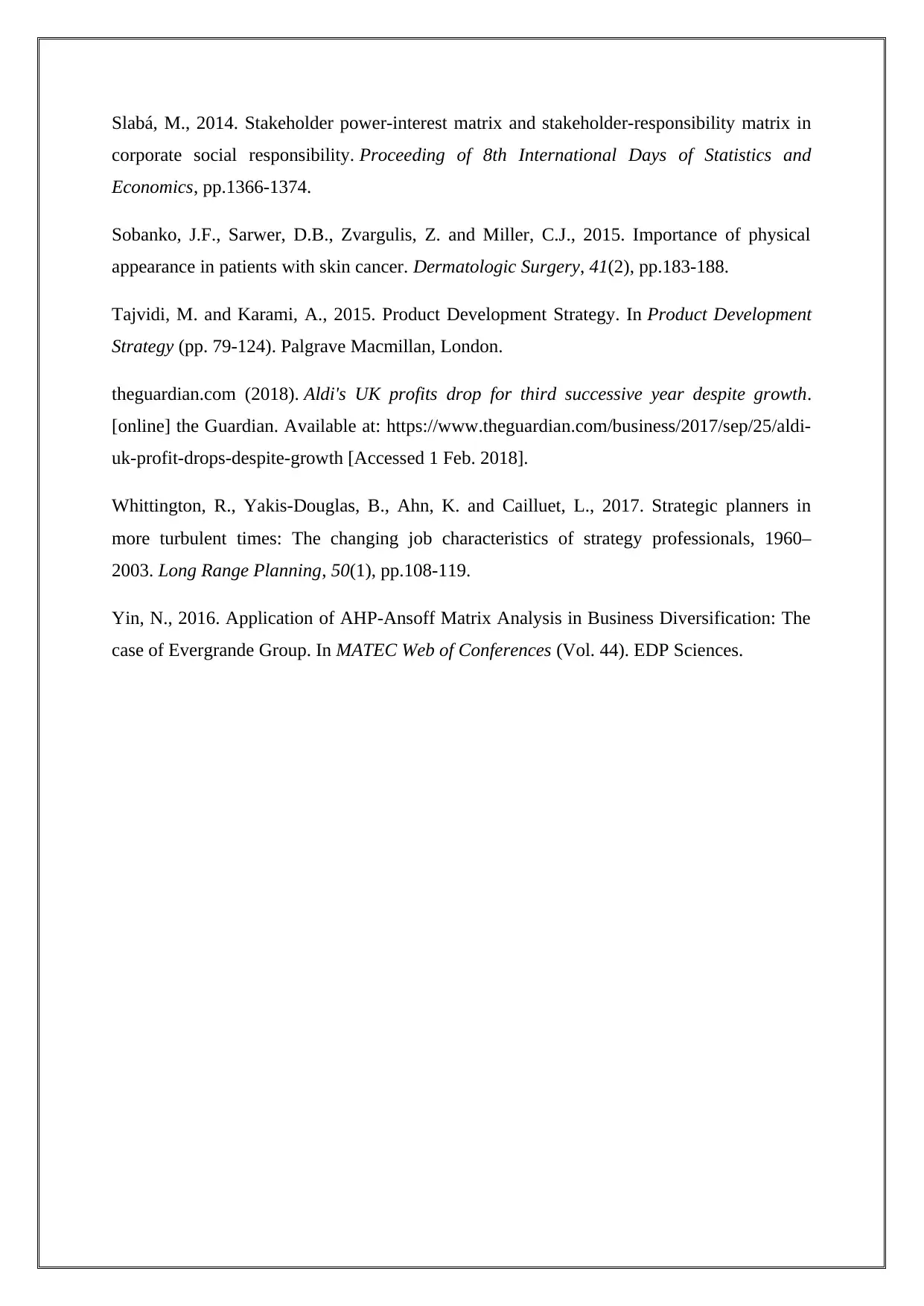
Slabá, M., 2014. Stakeholder power-interest matrix and stakeholder-responsibility matrix in
corporate social responsibility. Proceeding of 8th International Days of Statistics and
Economics, pp.1366-1374.
Sobanko, J.F., Sarwer, D.B., Zvargulis, Z. and Miller, C.J., 2015. Importance of physical
appearance in patients with skin cancer. Dermatologic Surgery, 41(2), pp.183-188.
Tajvidi, M. and Karami, A., 2015. Product Development Strategy. In Product Development
Strategy (pp. 79-124). Palgrave Macmillan, London.
theguardian.com (2018). Aldi's UK profits drop for third successive year despite growth.
[online] the Guardian. Available at: https://www.theguardian.com/business/2017/sep/25/aldi-
uk-profit-drops-despite-growth [Accessed 1 Feb. 2018].
Whittington, R., Yakis-Douglas, B., Ahn, K. and Cailluet, L., 2017. Strategic planners in
more turbulent times: The changing job characteristics of strategy professionals, 1960–
2003. Long Range Planning, 50(1), pp.108-119.
Yin, N., 2016. Application of AHP-Ansoff Matrix Analysis in Business Diversification: The
case of Evergrande Group. In MATEC Web of Conferences (Vol. 44). EDP Sciences.
corporate social responsibility. Proceeding of 8th International Days of Statistics and
Economics, pp.1366-1374.
Sobanko, J.F., Sarwer, D.B., Zvargulis, Z. and Miller, C.J., 2015. Importance of physical
appearance in patients with skin cancer. Dermatologic Surgery, 41(2), pp.183-188.
Tajvidi, M. and Karami, A., 2015. Product Development Strategy. In Product Development
Strategy (pp. 79-124). Palgrave Macmillan, London.
theguardian.com (2018). Aldi's UK profits drop for third successive year despite growth.
[online] the Guardian. Available at: https://www.theguardian.com/business/2017/sep/25/aldi-
uk-profit-drops-despite-growth [Accessed 1 Feb. 2018].
Whittington, R., Yakis-Douglas, B., Ahn, K. and Cailluet, L., 2017. Strategic planners in
more turbulent times: The changing job characteristics of strategy professionals, 1960–
2003. Long Range Planning, 50(1), pp.108-119.
Yin, N., 2016. Application of AHP-Ansoff Matrix Analysis in Business Diversification: The
case of Evergrande Group. In MATEC Web of Conferences (Vol. 44). EDP Sciences.
1 out of 21
Related Documents
Your All-in-One AI-Powered Toolkit for Academic Success.
+13062052269
info@desklib.com
Available 24*7 on WhatsApp / Email
![[object Object]](/_next/static/media/star-bottom.7253800d.svg)
Unlock your academic potential
© 2024 | Zucol Services PVT LTD | All rights reserved.





